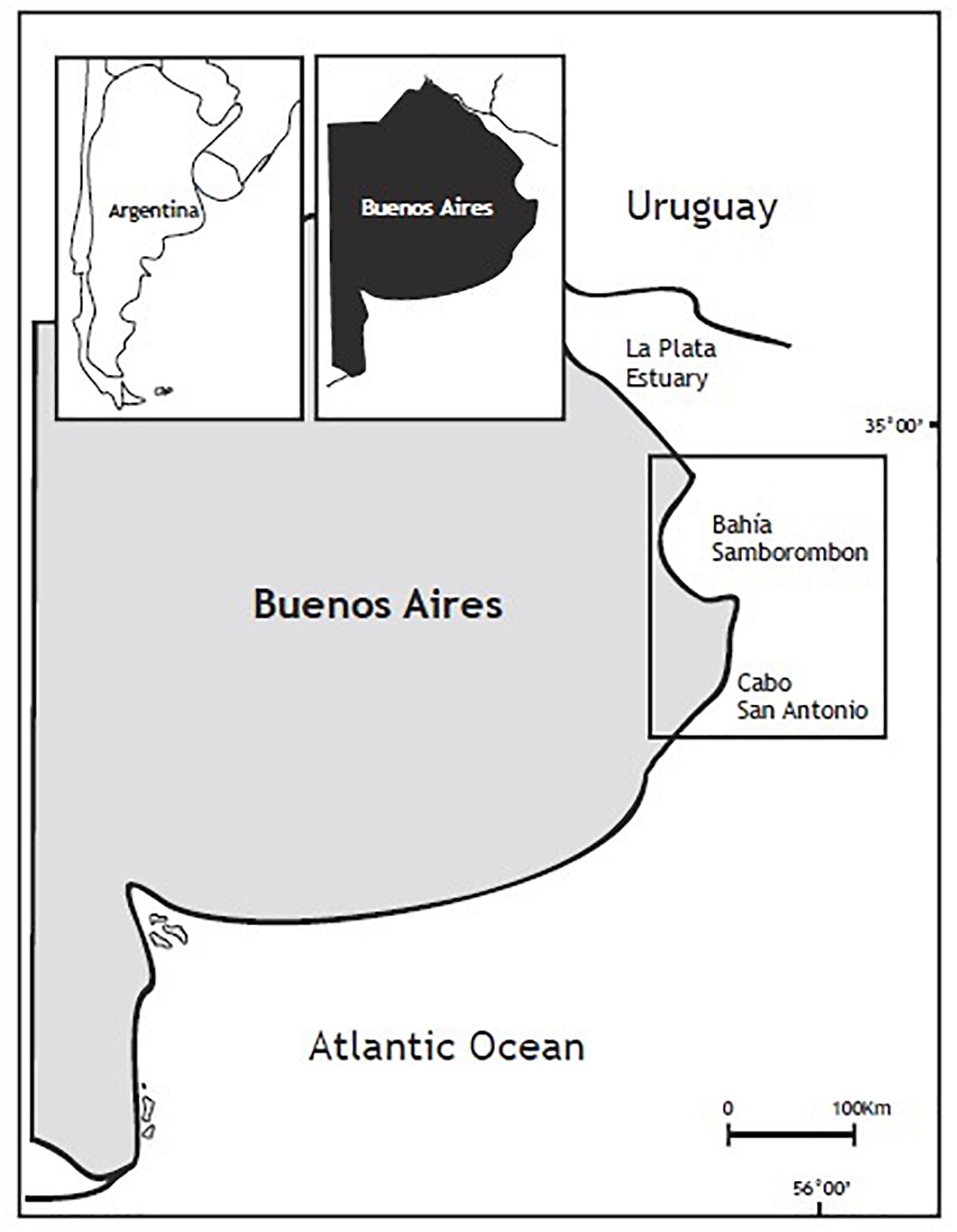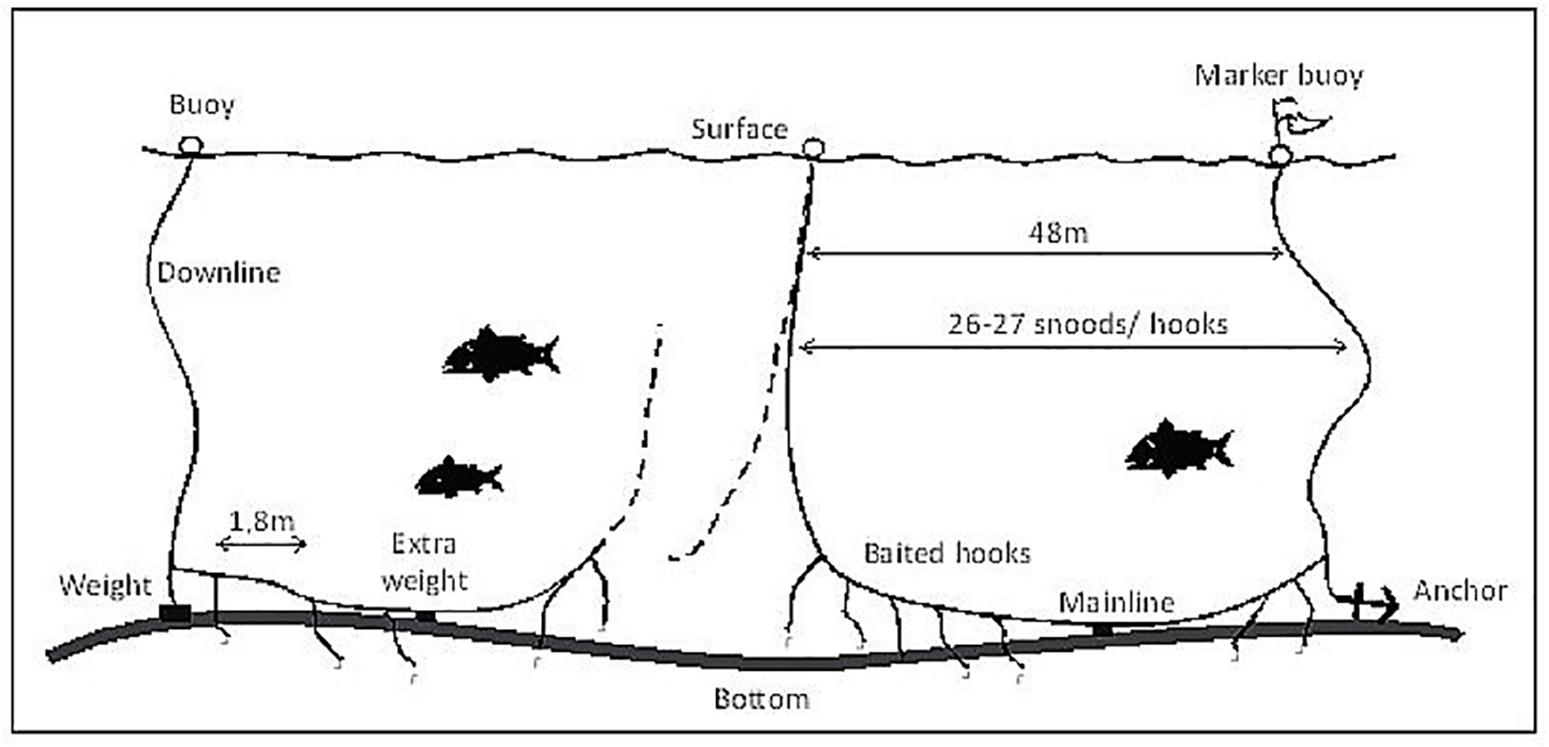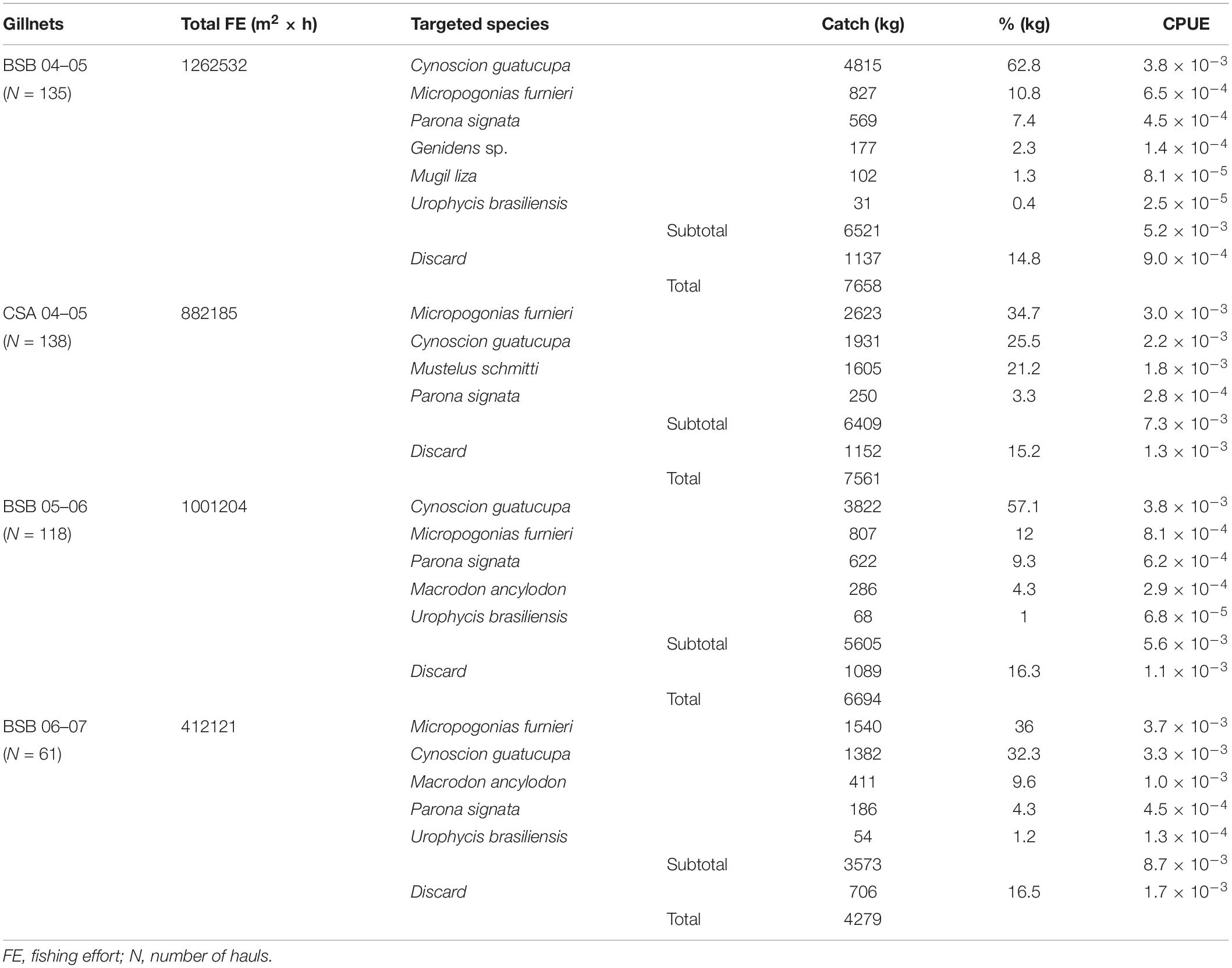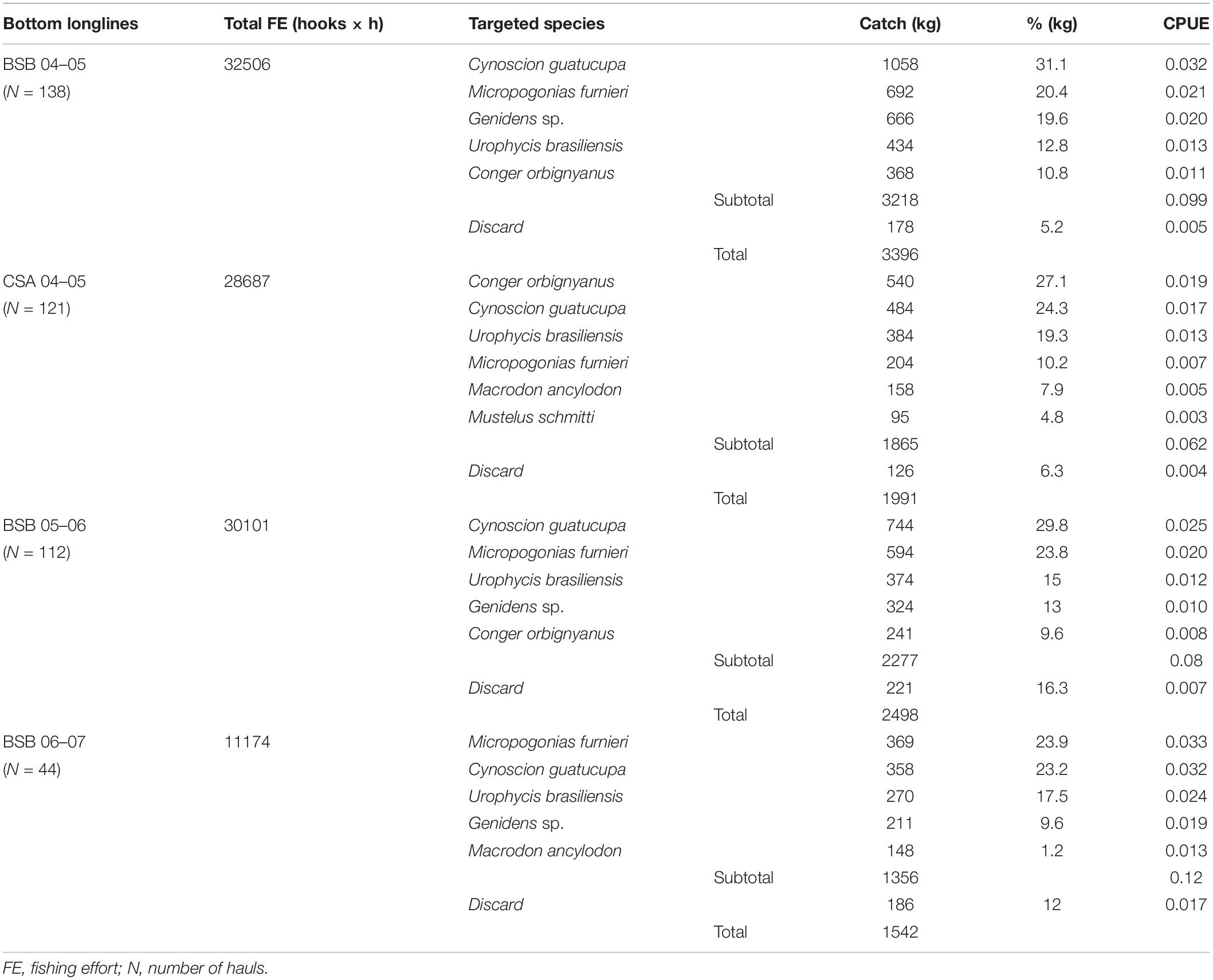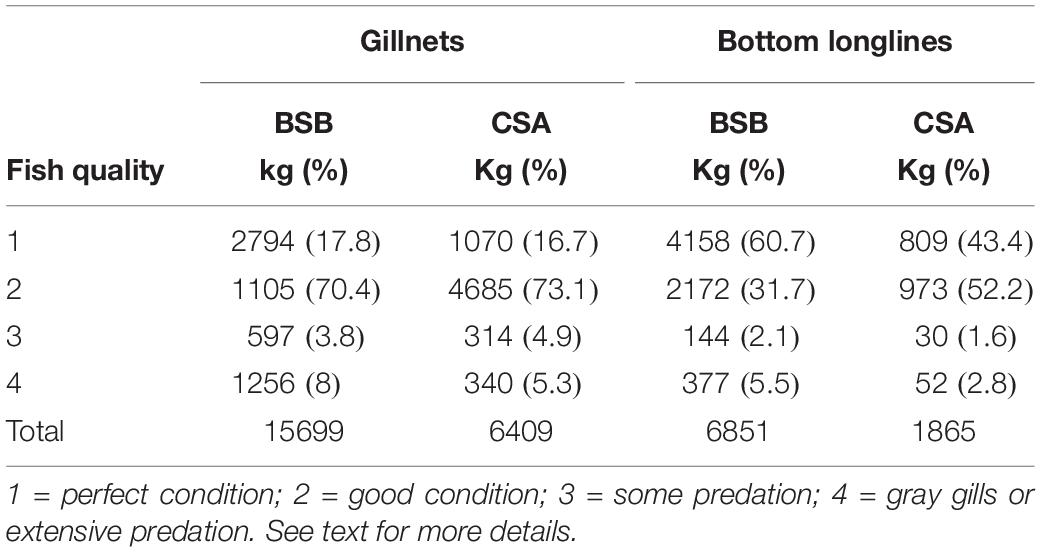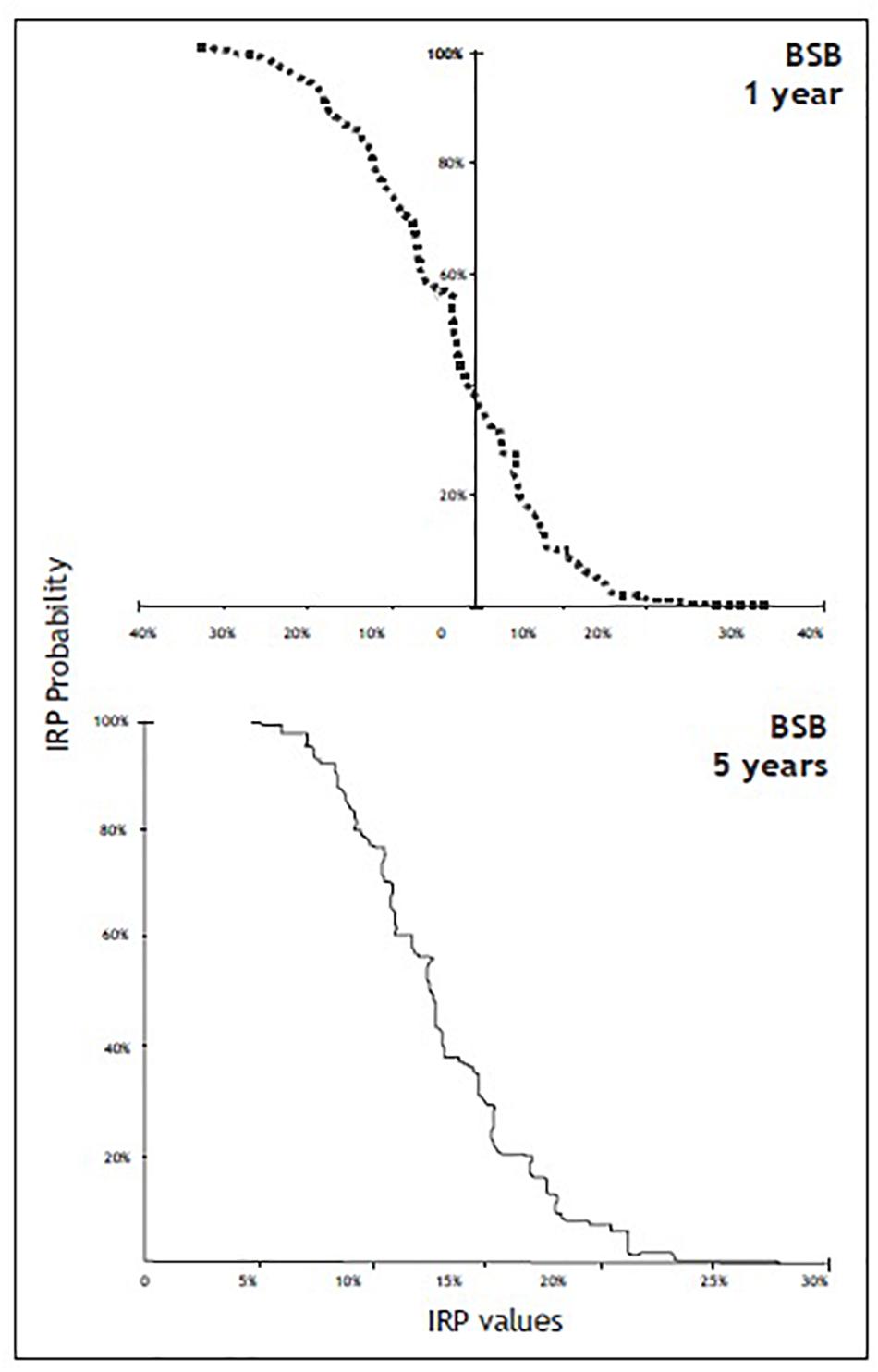- 1AquaMarina – Centro de Estudios en Ciencias Marinas, Buenos Aires, Argentina
- 2Fundación Universidad Empresa de la Provincia de Cádiz – Universidad de Cádiz, Cádiz, Spain
- 3Centro de Investigação Marinha e Ambiental, Universidade do Algarve, Faro, Portugal
- 4Facultad de Ciencias Económicas y Sociales, Universidad Nacional de Mar del Plata, Buenos Aires, Argentina
- 5Sea Mammal Research Unit, Scottish Oceans Institute, University of St Andrews, St Andrews, United Kingdom
- 6Ocean Associates Inc., Arlington, VA, United States
- 7UMASS-Boston, Boston, MA, United States
The franciscana dolphin (Pontoporia blainvillei) is considered the most threatened cetacean in the South Western Atlantic due to bycatch in gillnet fisheries of Argentina, Uruguay, and Brazil. As gillnet fisheries operate in the same areas inhabited by dolphins, methods and strategies to reduce bycatch require particular attention. This study investigated the potential of switching gillnets to bottom longlines to reduce franciscana bycatch rates while maintaining economic returns in a small-scale artisanal fishery in Argentina. Trials were conducted in Bahía Samborombón and Cabo San Antonio between October 2004 and January 2007, in cooperation with artisanal fishermen who simultaneously fished using bottom longlines and gillnets. Target and non-target catch composition, fishing yield, catch size distribution and quality of catch, as well as bycatch of dolphins, sea turtles, and interaction with sea lions were compared between the two fishing methods to assess the profitability of switching fishing gears. Hauls of both gear types deployed simultaneously in the same locations showed similar fish catch composition and catch size with both gears but reduced catch of juvenile fishes in longlines. Bycatch of franciscana in bottom longlines was limited to only one dolphin in three consecutive years of trials, and no direct interaction between turtles and hooks were recorded. The economic analysis showed financially acceptable perspectives under a 5-year scenario. Reducing gillnet effort by switching to bottom longlines appears a practical approach to creating a sustainable fishery that could result in significant mitigation of current bycatch of franciscana dolphins in Argentina. However, implementation requires acceptance and compliance by the artisanal gillnet fishery.
Introduction
Incidental capture of non-target species during fishing operations (bycatch) is a major source of mortality to many marine animals that form critical parts of marine food webs. It has been identified as the most immediate threat to the survival of many endangered marine mammals, elasmobranches, sea turtles, and seabirds (Lewison et al., 2004a; Werner et al., 2006; Goldsworthy and Page, 2007; Read, 2008; Anderson et al., 2011; FAO, 2018a). Cetacean bycatch is particularly serious given their inherent low reproductive rates, long life span, and later maturation age (Lewison et al., 2004a), all of which limit their ability for rapid population recovery. A number of approaches have been implemented to mitigate cetacean bycatch including changing fishing practices, limiting fishing effort by implementing time-area closures, modifying fishing gear and using technological devices such as acoustic alarms (‘pingers’) (Hall, 1996). Some progress has been made in mitigating this problem in commercial fisheries located in developed countries (Dawson et al., 2013; Northridge et al., 2017). On the other hand, there are only a few examples from small-scale non-industrial fisheries in developing countries (Mangel et al., 2010; Bielli et al., 2020).
The majority of bycatch of small cetaceans is believed to occur in gillnets (Read et al., 2006). Gillnets, which are one of the most popular fishing gears worldwide (He, 2006) are widely used in small-scale coastal artisanal fisheries because they are relatively inexpensive, require little infrastructure, and can be deployed and retrieved easily on land or using small boats. An approximation of the significance of the artisanal sector using FAO (2018b) information on the global fishing fleet is that 86% of all fishing vessels have a length of 12 m or less and are mostly undecked. Small-scale fisheries are important to local economies, involving more than 90% of the world’s fishing workforce, producing about half of global annual fish catches and also providing most of the fish for human consumption in the developing world (Berkes et al., 2001).
Bycatch of franciscana dolphins (Pontoporia blainvillei) in artisanal gillnet fisheries has been identified as the primary conservation threat throughout most of its range in Brazil, Uruguay, and Argentina (Reeves et al., 2012). Franciscana reach sexual maturity between 2 and 4 years -one of the earliest age ranges of maturity reported for any cetacean- and have a maximum life span of approximately 20 years (Kasuya and Brownell, 1979; Danilewicz, 2000; Panebianco et al., 2012; Negri et al., 2014). As a result of this short life span and low reproductive potential the species has a limited ability to recover from current high levels of bycatch across its range (Cappozzo et al., 2007; Negri et al., 2012; Prado et al., 2013, 2016; Szephegyi et al., 2015; Cremer et al., 2016). Based on a projected range wide decline of more than 30% over three generations, franciscana is classified as a “vulnerable” species (Reeves et al., 2012).
Four “management areas” have been proposed for the species based on a combination of morphological, ecological, and genetic differentiation; two inhabiting coastal central Brazil, one in southern Brazil and Uruguay, and one in Argentina (Secchi et al., 2003). The species’ distribution in Argentine waters is mainly restricted to coastal Buenos Aires Province, where bycatch of franciscana has been estimated at 360–650 individuals per annum (Pérez Macri and Crespo, 1989; Corcuera, 1994; Bordino and Albareda, 2004; Cappozzo et al., 2007; Negri et al., 2012). Franciscana abundance in Argentina has been estimated at about 14,000 individuals (Crespo et al., 2010), with 2.6–4.6% removed each year by gillnets. Annual bycatch rates that exceed ∼2% of a population size are generally considered unsustainable for small cetaceans (Perrin et al., 1994). This estimate of the proportion of the population removed by bycatch is based on the assumption of a single Argentinean population; however, genetic data indicate subpopulation structure in the region (Mendez et al., 2008; Gariboldi et al., 2015) that occur in environmentally distinct areas (Mendez et al., 2010). Although dolphins are considered highly mobile marine animals, franciscana show restricted movement patterns (Bordino et al., 2008; Wells and Bordino, 2013). The identification of subpopulations within a relatively small geographic area further underlines the importance of reducing the impact of bycatch on this species.
The multi-fleet coastal fishery of Northern Buenos Aires targets a coastal demersal association of about 30 fish species called ‘variado costero,’ using demersal trawls and bottom set gillnets. The gillnet sector of the fishery is a small-scale fishery that is economically vital to local coastal communities (Lagos, 2001; Garcia, 2010). Despite its importance, many aspects of the fishery, including management options, have not been comprehensively studied. The increase in fishing effort by trawlers in this region (Carozza, 2010), a decrease in the average catch size, an increase proportion of juvenile catch in the area (Ruarte and Aubone, 2004; Aubone and Lagos, 2007; Carozza and Hernandez, 2007), and the intensification of gillnet effort are directly linked to an increase in both bycatch risk and competition with marine mammals for prey species (Crespo et al., 1994; Weiskel et al., 2002).
A range of strategies to reduce franciscana bycatch in the gillnet sector of the fishery have been trialed, including the use of acoustic deterrent devices (ADDs) (Bordino et al., 2002, 2004) and testing the effectiveness of chemically modified gillnets (Bordino et al., 2013). The use of time-area closures to mitigate bycatch in the fishery are not considered a viable management option owing to the anticipated lack of infrastructure and support for monitoring and enforcement.
While the use of ADDs (pingers) resulted in a reduction in franciscana bycatch rates (Bordino et al., 2002, 2004), widespread adoption of these devices is hampered by the financial cost of purchase, unit maintenance and enforcement. There are also concerns that the repeated use of ADDs may result in habituation and/or habitat exclusion (Dawson et al., 2013). As ADDs are the only bycatch reduction technology so far shown to be effective with franciscana, additional investigation on how to reduce their cost and ruling out any unintended ecological consequences should be continued. Even though recent studies have shown that bycatch of small cetaceans can be reduced by LED devices (Bielli et al., 2020), this technology has never been tested in the area due to the characteristic murky waters. In the meantime, it is important to evaluate other fishing techniques that may offer incentives for fishermen to adopt them.
The following study was conducted to investigate if changing fishing gears in a small-scale artisanal fishery could reduce franciscana bycatch rates while maintaining comparable economic returns. Specifically we recorded total catch, comparative bycatch rates and commercial catch between gillnet and bottom longline operations fished concurrently, including target and non-target catch composition, fishing yield, catch size frequency distribution, discards, and quality of catch. An economic analysis of the fishery was performed to assess the potential profitability of switching fishing gears.
Materials and Methods
Study Areas
The experiment was conducted in the artisanal gillnet fisheries of Bahía Samborombón (BSB) and Cabo San Antonio (CSA), in northern Buenos Aires Province (Figure 1). The BSB and CSA are important reproductive and spawning areas for several fish species (Lasta and Acha, 1996; Acha et al., 1999; Acha and Macchi, 2000) but vary in both static and dynamic environmental features. Usually, around 80 small artisanal gillnet boats and 120 trawl vessels have licenses to operate in these two areas. Gillnet fishing is conducted using small inflatable and fiberglass boats 5–8 m in length, powered by 40–120 HP outboard engines, and operating at 0.5 to 7 km from the coast in depths ranging from 3 to 12 m. Gillnets consist of 50 m panels of white monofilament (diameter 0.50–0.60 mm) with a height of 3–6 m and a hanging ratio of 0.25. Stretched mesh sizes range from 90 to 140 mm. In general, each fisherman deploys 400 m of gillnets at a time consisting of 100–200 m strings separated from each other. Occasionally, some fishermen use up to 2000 m of gillnets in response to competition with local trawlers for what they consider an overfished resource. While approximately half the vessels fish year round, the majority of fishing effort occurs between September and April. At BSB there is a natural harbor (San Clemente del Tuyú), with fishing activity restricted by tidal state, while at CSA boats are launched from the beach using trailers and 4 × 4 vehicles. In both areas, the fishery is highly dependent on the wind especially in the austral spring and summer limiting the operational days (Lagos, 2001; Garcia, 2010). The two main target species of the fishery are Whitemouth croaker (Micropogonias furnieri) and Stripped weakfish (Cynoscion guatucupa). Landed catches are sold to local restaurants and tourists during the summer season, or to intermediates for exportation to Asia, Africa, Europe, and Brazil.
Fishing Gear Evaluation
The experiment was conducted between October 2004 – February 2005 at both study areas, and between October 2005 – February 2006 and November 2006 – January 2007 at BSB only due to logistical problems at CSA. The first fishing period involved ten fishermen (five fishermen at each study area) simultaneously fishing with bottom longlines and gillnets, while the second and third fishing periods involved five fishermen at BSB only. Fishermen used standardized fishing gear provided to them for the experiment. Gillnets were new and of the same dimensions commonly used by fishermen, all rigged identically, with 120 mm mesh size and monofilament 0.6 mm diameter. Each fisherman used one string of 100 m length and 3.5 m high. The experimental bottom longline consisted of 180 m of 5 mm ground line and 2 mm flat nylon drop lines (snoods) attached with knots approximately every fathom (1.8 m). Buoys were placed at each end and along the ground line every 27 snoods, and 1000 g of weight was placed every 14 snoods. Additional weight (100 g of tubular lead units) was placed every 6–7 snoods corresponding with buoy positions to control the depth of gear operation. Each bottom longline was rigged with 80 medium size J-shaped hooks (Mustad 2330 N°7). The design of the experimental bottom longlines was previously discussed with local fishermen and is shown in Figure 2. Each fishermen fished with one of these bottom longline units in addition to the gillnet string. During the first trial, hooks were baited with approximately 10–15 g pieces of fresh Brazilian menhaden (Brevoortia aurea), Argentine conger (Conger orbignyanus), or frozen Argentine shortfin squid (Illex argentinus), with a single bait type randomly assigned to each haul. Brazilian menhaden and Argentine conger, which are abundant and considered non-commercial species locally, were caught using the experimental gillnets and longlines, while Argentine shortfin squid was provided to fishermen. Gillnet strings and bottom longlines deployed by each boat were anchored in close proximity (approximately 100 m apart), in depths ranging between 4–12 m. Each fishing boat carried an independent observer who was rotated among boats throughout the course of the experiment. Observers recorded geographic position, soak time, type of bait, and biomass of fish caught by each fishing gear, as well as environmental conditions and bycatch.
The presence of and/or any interaction between marine mammals, seabirds and sea turtles with the fishing gear were also recorded at the beginning and at the end of each fishing haul, as well as the condition of every baited hook and the presence of any damage to gillnets. After hauling, the daily catch from gillnets and bottom longlines were separated by species and weighed. Discards of commercial fish in unsellable condition and non-commercial fish species were also recorded.
An index of commercial fish species occurrence (Isp) was calculated by the equation:
Where,
ni: number of times any given commercial species was caught by each fishing gear; and
N: total number of fishing sets per gear.
For each fishing gear type, all commercial species with Isp ≥ 50% were considered to be common species, while Isp > 75% and Isp < 25% were considered to be very common and rare species, respectively.
Total length (TL), measured to the nearest half centimeter was recorded for a random subsample of commercial fish species from each fishing haul. The selectivity of each fishing gear type was calculated from the catch size distribution by species, assuming that the selection range of the fishing gear is narrower than the stock size distribution. Thus, selectivity presented from TL frequencies of the catch, ignoring the stock size distribution, should be interpreted with caution as it provides only a rough estimate of the selection curve, and is therefore useful only in the context of this experiment comparing gear types. The TL frequency distributions by species were compared between fishing gears using Kolmogorov–Smirnov test (Siegel and Castellan, 1988).
The quality of the commercial fish catch was graded into four classes: (1) Fish in perfect condition (red gills or alive), (2) Fish in good condition (pink gills), (3) Fish partially deteriorated due to predation by sea lions, and (4) Fish in bad condition (gray gills and/or extensively depredated). Fish graded as class 3 or 4 were considered discards.
Fish catch per unit effort (CPUE) was used to assess the influence of factors such as fisherman, area and year on fishing yield. For gillnets and bottom longlines, the CPUE was calculated as kg of fish/m2/hr, and kg of fish/80 hooks/hr, respectively, for each set. The relative fishing performance between fishing gears was defined by CPUE of bottom longlines/CPUE of gillnets as a way to evaluate if any gear was more efficient than other throughout the trials. The number of bottom longline hooks required to obtain the average catch of 100 m of gillnets was estimated using the ratio between fish biomass (kg) caught per gillnet haul/fish biomass (kg) caught per bottom longline haul.
The effect of bait type on the relative fishing performance of bottom longlines was analyzed using the CPUE and bait loss rate. The bait loss rate was calculated as the number of unbaited hooks/number of baited hooks with no catch at the end of each haul. Due to the smaller sample size from CSA, analysis of the effect of soak time on catch rates in gillnets and bottom longlines was restricted to data collected at BSB.
As units of fishing effort were different for the two gear types, the bycatch per unit effort (BPUE) for dolphins, sea turtles and seabirds were calculated as the number of individuals captured per total biomass (kg) of commercial fish catch for each fishing gear type. To allow comparison with previous studies in the fishery BPUEdolphins in gillnets was recalculated as the number of bycaught dolphins per km net–1 hr–1.
South American sea lion (Otaria byronia) depredation on both gear types was calculated as the number of attacks/kg of total fish catch (APUE). An attack was recorded when a fisherman determined, based on experience, that observed damage to fish and/or the fishing gear had been caused by sea lions, as opposed to sharks. Multiple attacks within a single fishing operations were assumed to be the same event.
Independence among fishing gear hauls was assumed for both gears. The daily CPUE in gillnets and bottom longlines were analyzed with Kruskal–Wallis non-parametric test once assumption for normality was not met (Cohen and Fowler, 1990).
Economic Analysis of the Fishery
To determine the economic effect of switching from gillnets to bottom longlines economic analyses were conducted using data collected through interviews from 21 local artisanal fishermen at BSB (5 of them were also involved in the trials). Information provided by the fishermen included the following: cost of manufacturing and maintaining fishing gear, depreciation of fishing gear, fuel consumption and labor (usually either fixed or as a percentage of daily fishing production). The average of these costs were used for the analysis. All costs were valued in kg of fish as this is the way that many local fishermen estimate their costs and using this metric avoids expressing any monetary value that would be highly variable as affected by local economic conditions. The average commercial fish catch rate for gillnets recorded during this experiment was compared to a combination of historical catch rates obtained by interviews with local artisanal fishermen and records from the Coast Guard. The analysis assumed that the fleet is homogeneous in terms of average cost-per-unit-effort, and that market price is not affected by landing volumes. Effort was set as an average of 80 operational days per fishing season. Due to the smaller sample size, economic analysis was not conducted for CSA.
The total gross revenue (TGR) was estimated as the average seasonal biomass of commercial fish caught per fisherman. The operational cost (OC) included fuel gas and oil, boat maintenance, insurance, taxes, and fishing gear and manufacturing. Gross value added (GVA) was calculated as the TGR minus OC. Labor cost (LC) was calculated as crew personnel cost including hooking bait and cleaning. Gross cash flow (GCF) was calculated as GVA minus LC. The economic profit (EPR) was calculated as the GCF minus depreciation (D) of manufactured fishing gear. The gear depreciated at 100% over the duration of the study period for gillnets, and was calculated at 25% of the initial cost for bottom longlines. It was assumed that D was not a function of maintenance (M). Depreciation on boat and engine and the interest on owner’s capital were not considered. The profit margin (PRM) and the return on investment (ROI) were defined, respectively as:
where total assets represent the value of the initial investment including a used boat with a 60–90 HP outboard engine, fishing gear (considering the comparative gillnet and bottom longline effort determined during this experiment), annual insurance and taxes, cost of fuel, labor crew, and bait cleaning hooks. The economic performance, based on the commercial fish catch rates obtained during the trials at BSB was estimated for three scenarios: 100% gillnet effort, 100% of bottom longline effort, and a hypothetical combination of 50% gillnet and 50% bottom longline effort.
An additional comparative economic analysis was conducted using a residual approach, which allows evaluation from an investor’s perspective to decide if a project is financially acceptable or not. The evaluation was made using a financial model considering the risk of investment by the variables: (a) biomass of commercial fish caught for sale, and (b) their local market price. This risk was analyzed through the Hertz Simulation Model (Hertz, 1964). The analysis used the Incremental Internal Profitability Rate (IRP) because the scale of the investment is dependent on the type of fishing gear used. The Hertz Simulation Model is one of the most frequently used in financial evaluations, providing a probability function to the IRP, which is built from the probability functions of the aleatory variables. The model selects the variables of higher influence associated with income, market, investment and costs, and assigns them probabilities according occurrence to ranges of variation. If these ranges are combined, different possible alternatives are established which will have a return rate and a value determined by the associated probability. The result is a function of probability for IRP, and the model will then produce the probability of reaching or overcoming a determined IRP. To determine if the project is viable or not, it is necessary to define a minimum acceptable revenue level. The advantage of this model is that investors may define their own minimum expectations for profitability. In this analysis, the model used the nominal monthly interest for deposits at the Banco Central de la República Argentina1 in 2007, which was 0.89%. Although this is the rate used for the current study, it will not be static and may not reflect the actual interest rate that should be used at a given point in time. Different scenarios for 1 and 5 years were tested, considering initial investment for boat and type of fishing gear, as well as basic expenses such as fuel, oil, crew, maintenance, insurance and taxes. To define the combination of the independent aleatory variables, probabilities were assigned to the total fish catch and the price range assuming a normal distribution. The following assumptions were made in the model: (1) All catch of commercially targeted species is sold in the market at homogeneous price range; (2) Fish catch and quality are the same for both gear types; (3) The price range is distributed normally in seven categories represented by 3.5%, 10%, 19%, 35%, 19%, 10%, and 3.5%; (4) The costs for crew, fuel oil and boat maintenance is independent of the fishing gear used; (5) There is a minimum of 80 fishing days per fishing season regardless of gear type used; (6) Each fishing gear is hauled only once a day; (7) The gillnetting fleet has a common cost structure, and; (8) The skill of skippers and crew is homogeneous and fishing capacity can be extrapolated to the fleet.
Ethical Approval
The experiment described in this paper was carried out in accordance with the current laws of the country regarding artisanal fisheries practice. Fish were taken from the fishing gears that artisanal fishermen fish legally on a daily basis. Data was obtained by counting and measuring normal fish catch and no manipulation of live animals was done. No additional permits were required but there was a consensus from the researchers to stop the project if the new fishing gear had higher rates of bycatch than the normal rate. Information regarding income, expenses and profit for performing the economic analysis included in this manuscript was obtained through a series of interviews to the fishermen which were carried out by the local conservation NGO, AquaMarina.
AquaMarina used a semi-structured interview format with fishermen who also participated in the fieldwork. None of the organizations that funded this work required an ethics review for these interviews. Nevertheless, AquaMarina adopted some standard protocols cognizant of important ethical considerations. Interviews were carried out by students hired by the project who received orientation about its objectives and interview protocols. Consent was received from all participants prior to conducting the interviews. The interviews were performed individually to each fisherman at the beach sites were they usually launch their boats on a daily basis for going out fishing. Prior to each interview, the objectives of the project were restated for the fishermen who were afforded the opportunity to ask any clarifying questions about the study or interviews. The names of respondents were recorded but their responses kept anonymous. There was no commercial or other use for the information recorded except for this study. That being the case, the project was carried on normally and thus exempt from ethical approval.
Results
Fishing Gear Evaluation
Locations of gillnet and bottom longline hauls are shown in Figure 3. Mean depth of fishing operations was 5.2 ± 2.1 m at BSB, and 7.2 ± 2.3 m at CSA. The mean soak time (mean ± standard deviation) at BSB was 23.3 ± 2.9 h and 3.1 ± 0.93 h for gillnet and bottom longline, respectively, and 20.8 ± 2.1 h and 3.0 ± 0.89 h, for gillnet and bottom longlines, respectively, at CSA. Although in some cases both gears at both areas had soak times of up to 75 h due to adverse weather conditions that prevented fishermen from retrieving gear earlier, these hauls were not considered for the analysis. There was no significant difference in depth or soak time for each gear in gillnets or bottom longlines throughout the three consecutive fishing seasons at BSB (P > 0.05, Kruskal–Wallis test, pair-wise comparison with Dunn’s test). A summary of fish catch by fishing gear type is presented in Tables 1, 2. In total, 13 fish species were caught with both fishing gear types at the two study areas, nine of which were local commercial species, with eight and seven commercial species caught in gillnets and bottom longlines, respectively. Of the very common (Isp > 75%) and common species (Isp ≥ 50%) being targeted, gillnets and bottom longlines caught three and four species, respectively, that dominated the catches of both gear types (Table 3). The two main target species were Stripped weakfish and Whitemouth croaker, which represented 80% and 52% of the total biomass caught in the pooled study areas (excluding discards), in gillnets and bottom longlines, respectively. Parona leatherjack (Parona signata) and Mullet (Mugil liza) were caught only in gillnets, and Argentine conger (Conger orbignyanus) was only caught in bottom longlines and was also the most frequently caught species at CSA. Among all commercial species with the highest value in the local market, Brazilian codling (Urophycis brasiliensis) and Catfish (Genidens sp.) represented only 1.5% and 31% of the total catch (excluding discards) in gillnets and bottom longlines, respectively. Mullet and Catfish were exclusively caught in BSB, while Patagonian smooth-hound (Mustelus schmitti) was only caught in CSA.
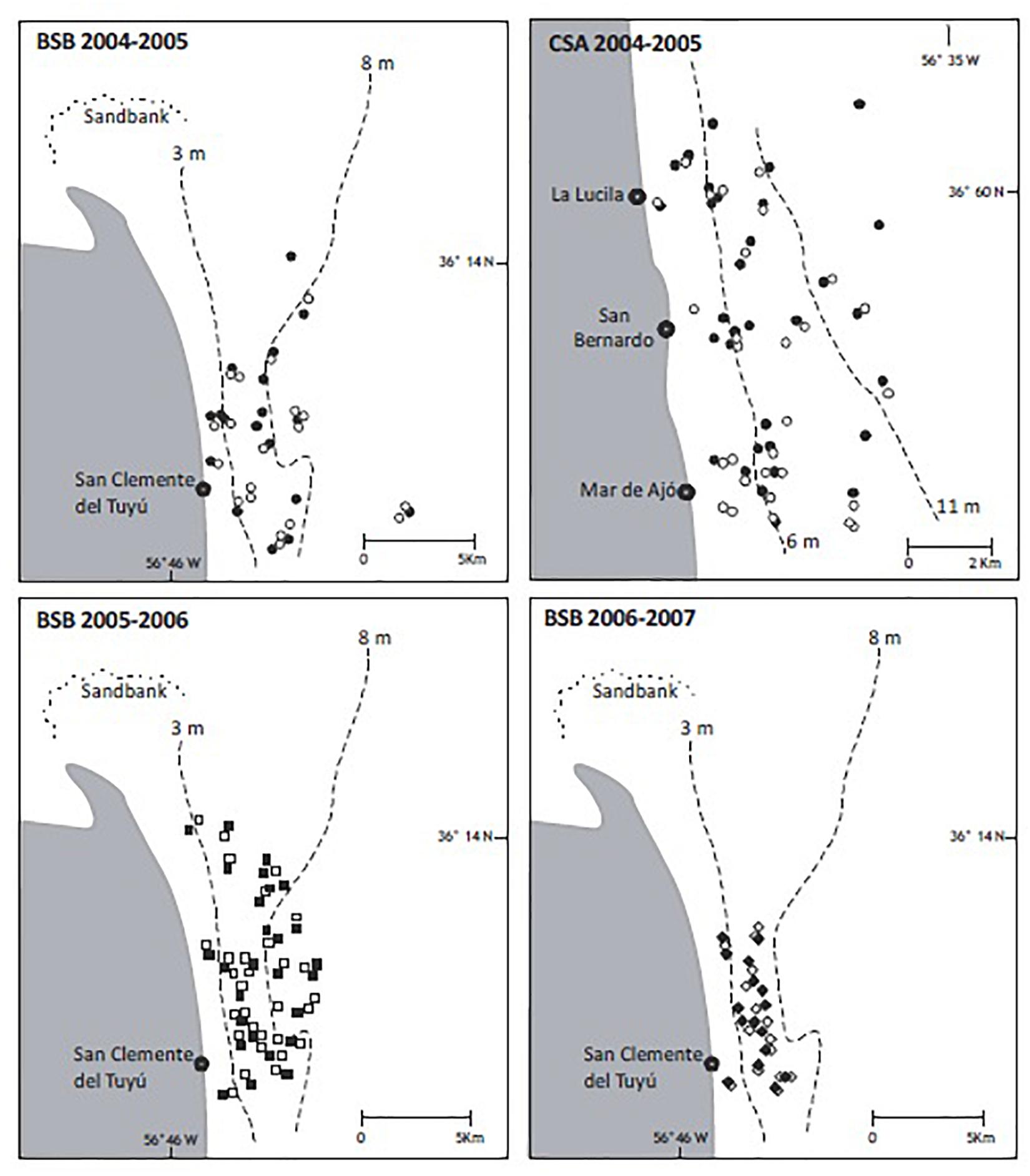
Figure 3. Location of gillnets (black) and experimental bottom longlines (white) hauls in Bahía Samborombón (BSB) and Cabo San Antonio (CSA).
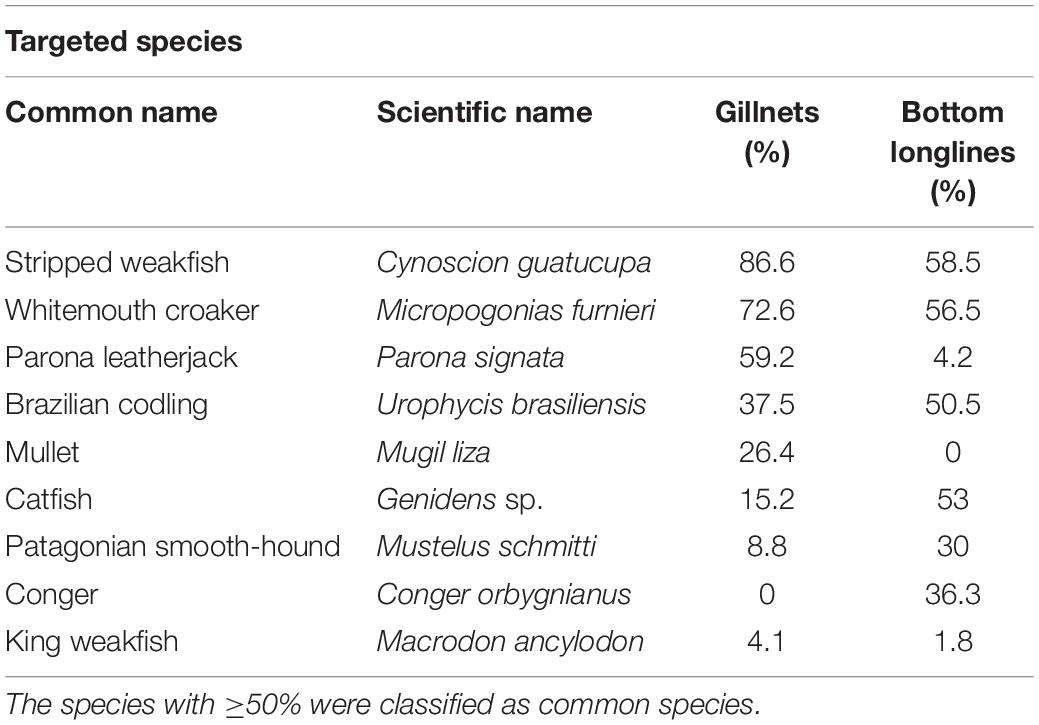
Table 3. Combined species occurrence index (%) showing species most commonly caught by both fishing gear types.
No significant differences in the CPUE among fishermen with gillnets or bottom longlines were found at BSB or CSA (P > 0.05, Kruskal–Wallis test, Pair-wise comparison with Dunn’s test), and therefore the CPUEs were combined at each study area. Preliminary data analysis for the first trial (2004–2005) showed a significantly higher CPUE for commercial species with gillnets at CSA than BSB, and with bottom longlines at BSB than CSA (P < 0.001, Mann–Whitney test). These differences were confirmed by the relative fishing performance of bottom longlines to gillnets which was 19 at BSB and 8.5 at CSA during the first trial. This relative fishing performance of bottom longlines was 14.3 and 13.8 in the second and third trials, respectively, at BSB. Considering only the data set from BSB, the CPUE in gillnets or bottom longlines were similar during the three trials (P > 0.05, Kruskal–Wallis test, pair-wise comparison with Dunn’s test), although the CPUE was more variable in bottom longlines than gillnets (Figure 4). The mean daily catch rate of bottom longlines at CSA was 0.19 ± 0.06 kg/hook, and 0.31 ± 0.05 kg/hook at BSB.
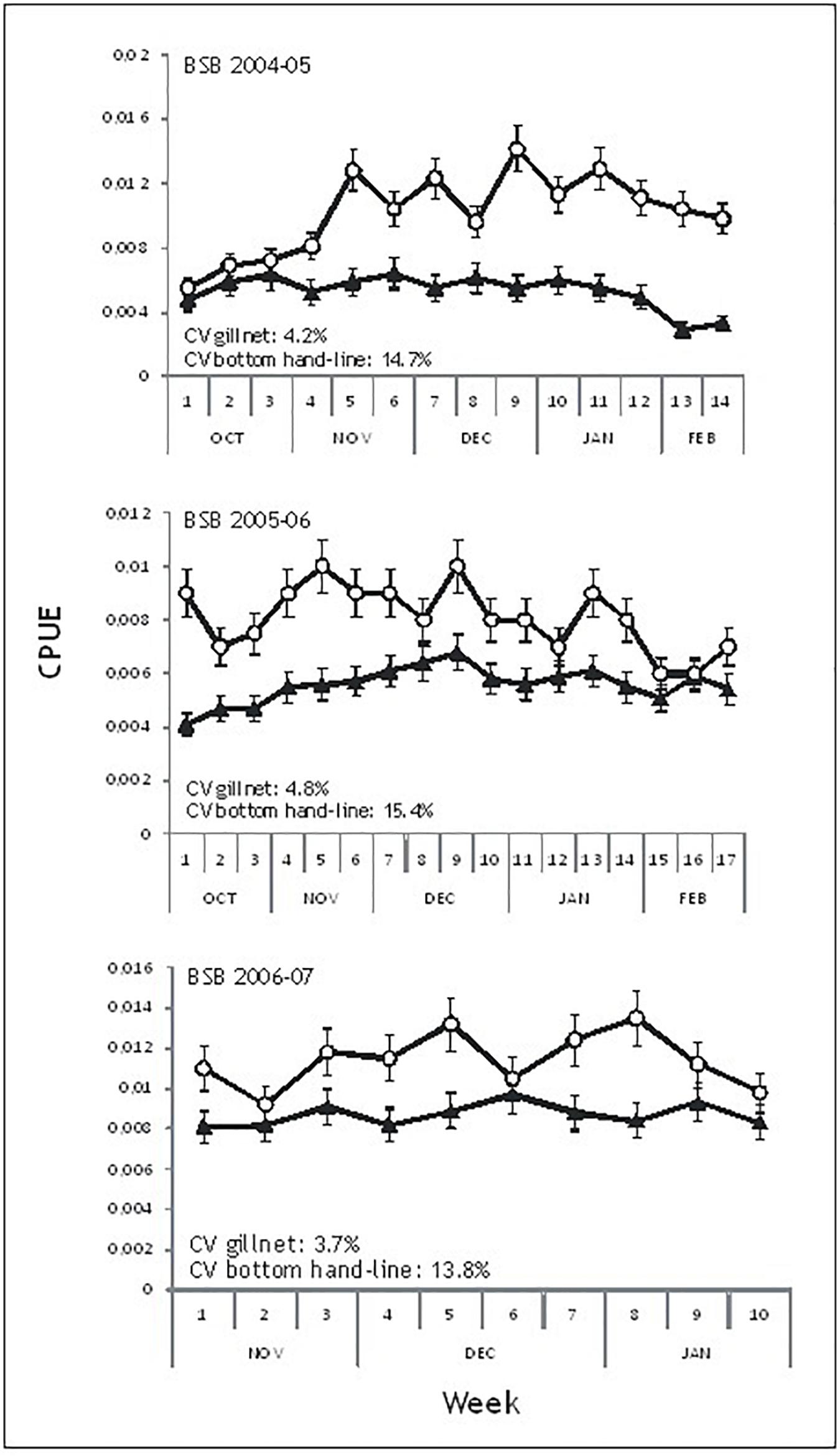
Figure 4. Variability of CPUE and SE in gillnets (black triangle) and bottom longlines (white circle) in BSB. THE CPUE for bottom longlines is expressed as CPUE– 1.
The range of catch sizes of the two main targeted species, Whitemouth croaker and Stripped weakfish, overlapped with no evidence of differences in size frequency distribution between BSB and CSA in either gillnets or bottom longlines (P < 0.05, Mann–Whitney test). The pooled total length frequency distributions for gillnets and bottom longlines were similar for each paired species caught by both fishing gear types (P > 0.001, Kolmogorov–Smirnov test, Figure 5). Six percent of Whitemouth croaker and 2% of Stripped weakfish caught in gillnets were below the minimum allowable catch sizes, as were 3% of Whitemouth croaker and 2% of Stripped weakfish caught by longlines in pooled study areas. Over 85% of the commercial fish catch was of the two highest quality classifications (perfect condition/alive and good condition) when caught by gillnets or bottom longlines, although bottom longlines had a higher percentage of fish hauled in perfect condition/alive (Table 4).
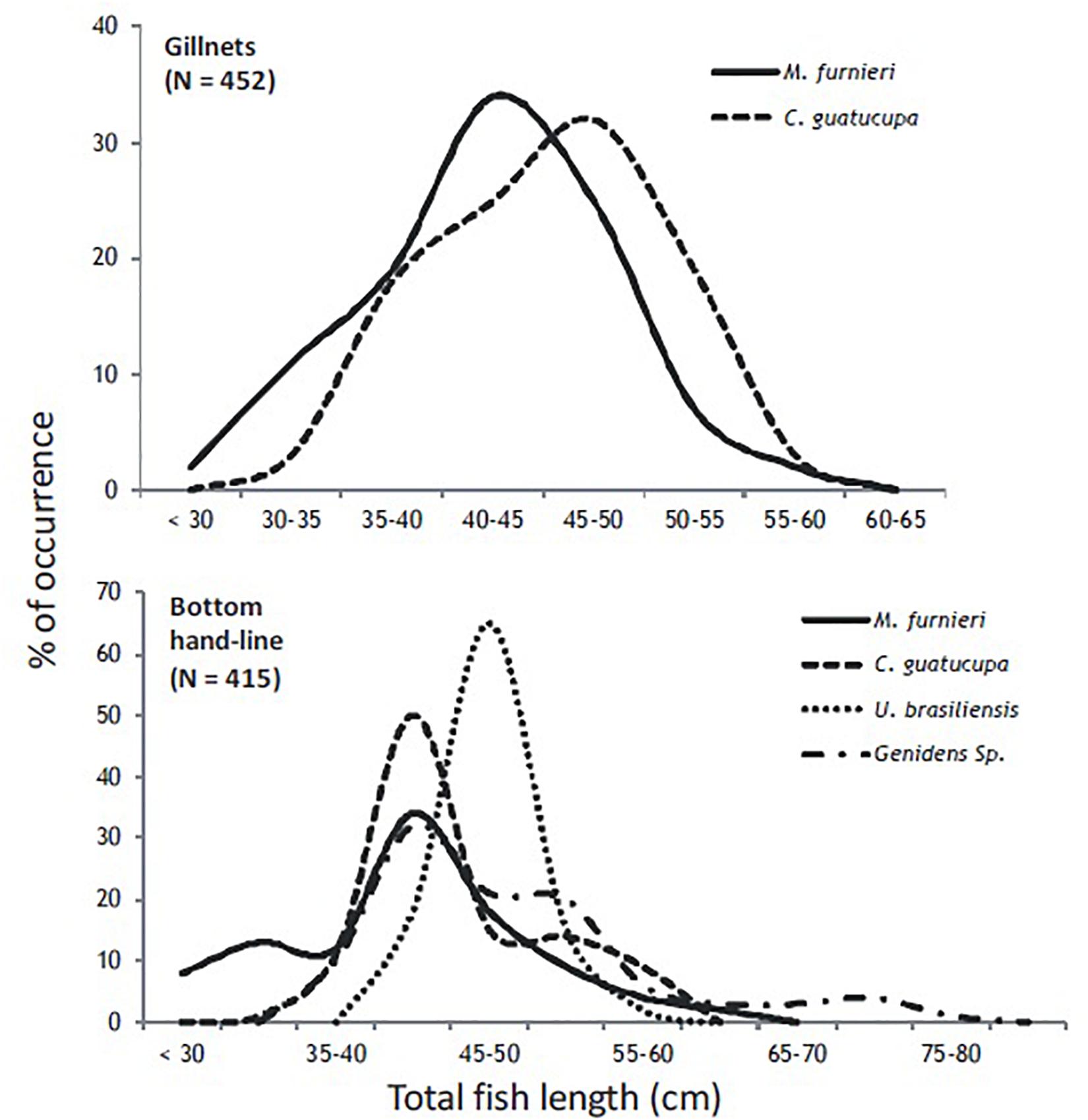
Figure 5. Pooled fish catch size length (TL) distributions for commercial fish species caught with both fishing gears in BSB and CSA.
There was a significant difference in both the CPUE and catch composition in bottom longlines in relation to the type of bait used (P < 0.05, Kruskal–Wallis test, P < 0.001, Kolmogorov–Smirnov test). The results of the first trial at BSB and CSA showed that the use of Brazilian menhaden resulted in higher CPUE and a lower bait loss rate than the other two baits used (Figure 6). Consequently, Brazilian menhaden was used as the sole bait type during the subsequent trials.
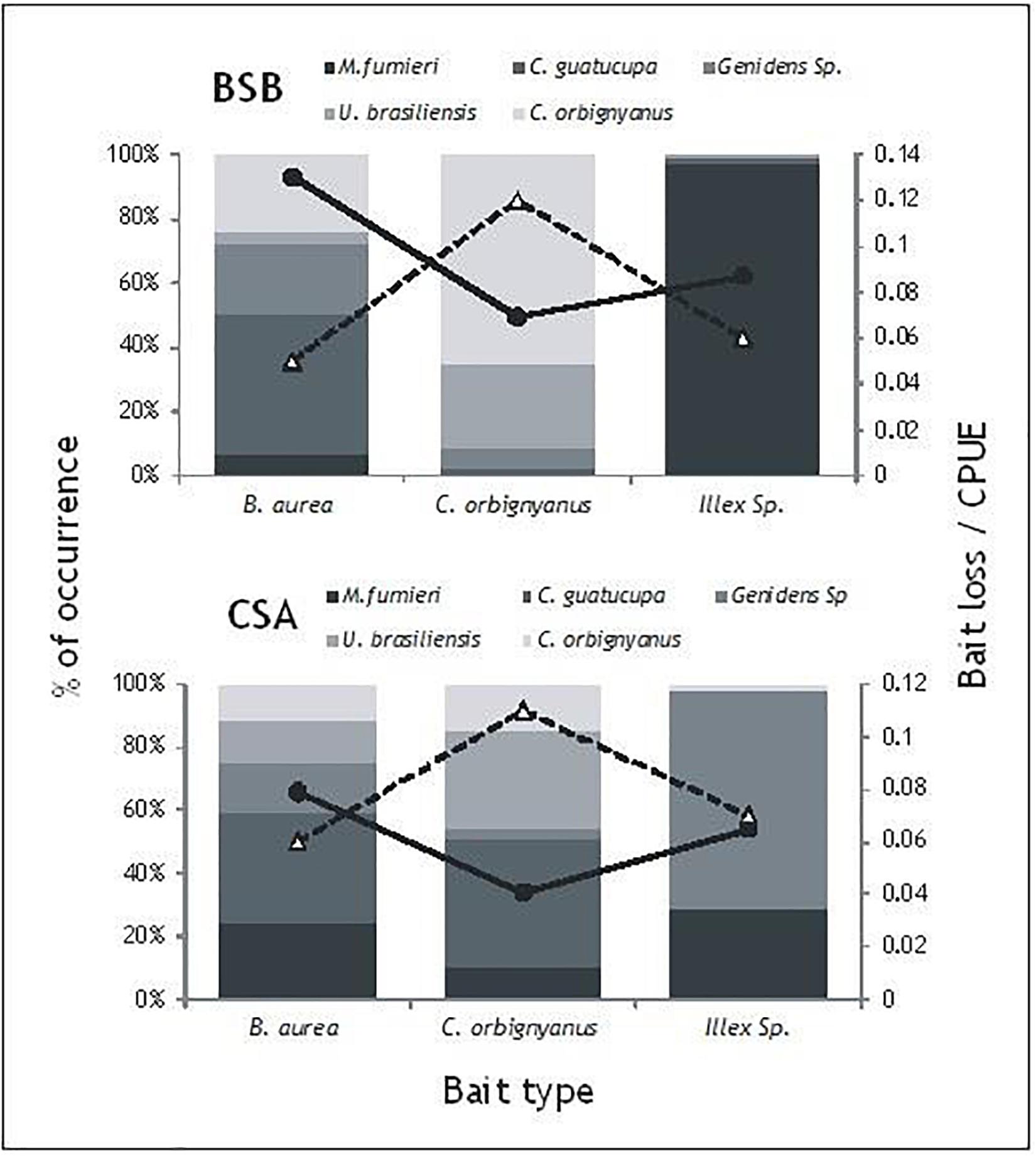
Figure 6. Commercial fish catch in relation to bait type and bait loss with bottom longlines in BSB and CSA. CPUE (black circle, full line), Bait loss rate (white triangle, dotted line).
Discards comprised commercial fish in poor condition or depredated by Southern sea lions or unidentified sharks. Within the pooled study areas, average discard in gillnets represented 15.7% of the total catch, while in bottom longlines it was 7.5%. From the pooled data set from BSB and CSA, sea lion interaction in gillnets and bottom longlines was recorded in 36% and 19% of hauls, respectively, with average depredation by sea lions occurred on 3% and 5% of commercial fish catch in gillnets and bottom longlines, respectively. The most frequently caught non-commercial species in gillnets was Brazilian menhaden, while in bottom longlines were Skate (Raja flavirostris), Angel shark (Squatina argentina), and Brazilian flathead (Percophis brasiliensis). Although these three species are occasionally sold as low value species, there was no local market for them at the time the experiment was conducted, and as a result catches of these species were excluded from the economic analysis. Three species of gastropods, Black volute (Adelomelon brasiliana), Fine volute (Zidona dufresneyi), and Rapa whelk (Rapana venosa) were also occasionally caught in bottom longlines but not considered in the analysis.
The average commercial fish catch in gillnets, excluding discards, was 48.3 kg/haul (BSB 04–05), 46.4 kg/haul (CSA 04–05), 47.5 kg/haul (BSB 05–06), and 58.6 kg/haul (BSB 06–07). The average commercial fish catch in bottom longlines, excluding discards, was 23.3 kg/haul (BSB 04–05), 15.4 kg/haul (CSA 04–05), 20.3 kg/haul (BSB 05–06), and 30.8 kg/haul (BSB 06–07). For the scale of this experiment, the relationship of commercial fish catch between gillnets and bottom longlines was 2.0 (BSB 04–05), 3.4 (CSA 04–05), 2.4 (BSB 05–06) and 2.6 (BSB 06–07), indicating that the bottom longline fishing effort would be roughly increased by 2.5 times to have equivalent catches as gillnets. A conservative estimate would be to use a minimum of 200 hooks to catch similar amount of commercial fish than 100 m of gillnets at BSB. Based on the catch rates recorded, it is then expected that each fisherman operating any daily string combination of 400 m gillnets would catch around 15,200–18,752 kg assuming 80 workable days per fishing season at BSB. This result is based on a linear relationship between catch abundance and length of longline which may not necessarily always be the case given variable target fish distributions and potentially other factors.
Comparative dolphin, sea turtle, and sea lion interactions with each gear type are shown in Table 5. No interactions with seabirds were recorded for either gear during the trials. In total, 85 dolphins were bycaught in 452 gillnet hauls from 71 bycatch events compared to one dolphin bycaught from 415 longline hauls. The dolphin was hooked by the pectoral fin and entangled in the snood and mainline and necropsy results showed that this individual had drowned. Seventy-seven green turtles (Chelonia mydas), three loggerhead (Caretta caretta), and two leatherback turtles (Dermochelys coriacea) were incidentally entangled in gillnets. Seven green turtles were released alive, while the remaining 75 turtles were found dead. Sea turtle entanglements in bottom longlines involved three green turtles and one leatherback, with all individuals caught either in the main or anchoring line. Two of the three green sea turtles were found alive and subsequently released, while the leatherback was suspected to have died before the entanglement, which was later confirmed by necropsy. No direct interaction between turtles and hooks were recorded.
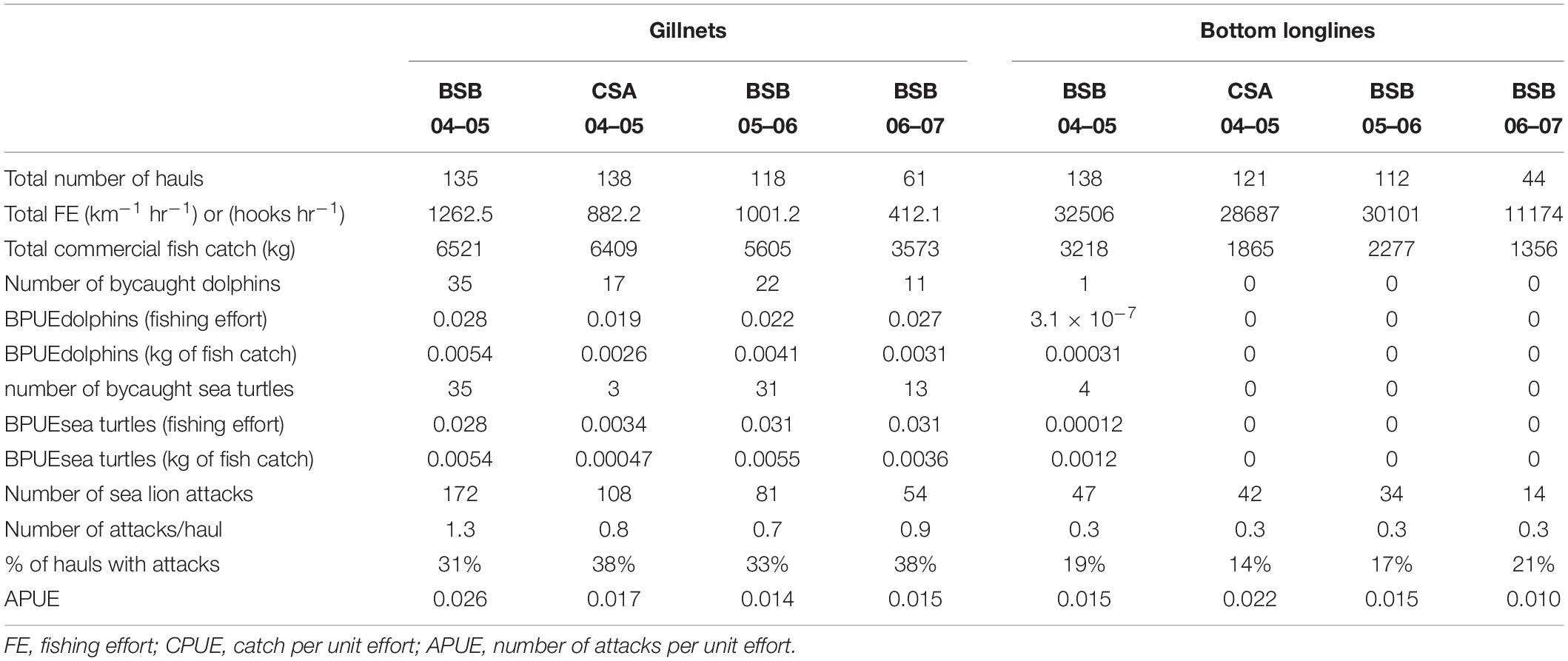
Table 5. Summary of interactions with franciscana dolphins, sea turtles, sea lions in relation to gear type, number of hauls, catch, and fishing effort.
Economic Analysis of the Fishery
Information on the most relevant cost indicators and total assets for artisanal fishing operations in BSB is shown in Table 5. A preliminary analysis showed that the commercial fish catch rate in gillnets during this experiment was significantly lower than the historical commercial fish catch rate estimated by combination of interviews with fishermen and records from the Coast Guard (Mann–Whitney test, P < 0.05). The estimated fish catch rates and probabilities assigned for the economic analysis are shown in Table 6. The analysis of the economic indicators shows that the profit margin (EPR), as well as the return on investment (ROI), is higher when operating 400 m of gillnets than 800 hooks in bottom longlines (Table 7). When using 50% of gillnet fishing effort (200 m) in combination with bottom longlines (400 hooks) simultaneously, the ROI would be about 8–10% lower than using gillnets alone when considering the estimated catch rates during this experiment and the combined data from interviews, respectively. The IRP was calculated from a total of 21,875 combinations of the aleatory variables: fish catch, and price. These combinations give IRP values between 5% and 27.8%, and between −33% and 29.8% for 5- and 1-year scenarios, respectively (Figure 7). These values indicate acceptable perspectives for economic and financial return of the investment under a 5-year scenario in 100% of the cases. However, for a 1-year scenario the values are acceptable in 30.2% of the cases only.
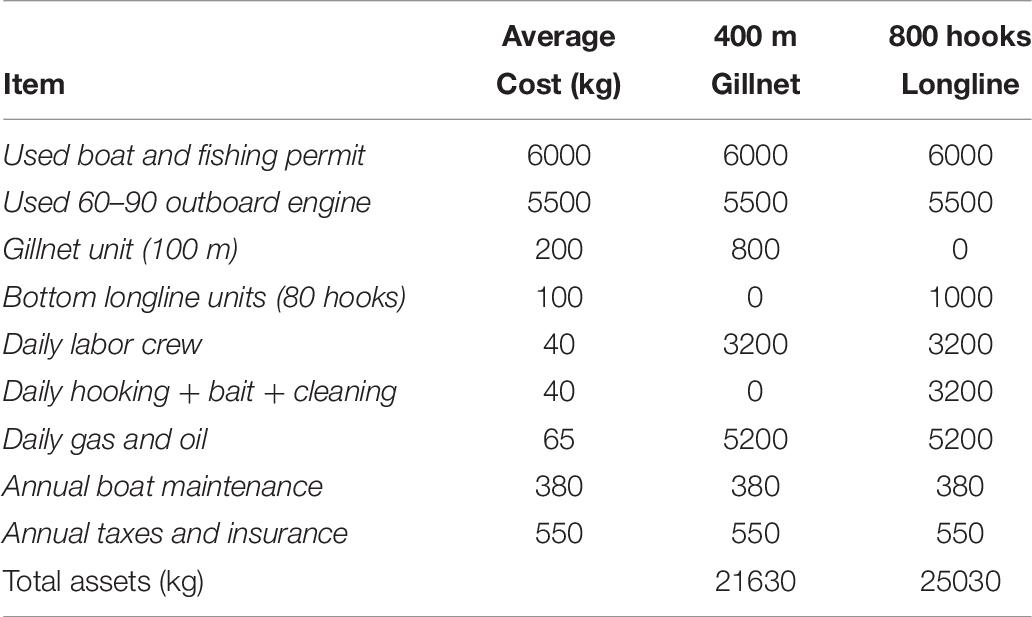
Table 6. Estimated unit cost (in kilograms of fish equivalent) for operational gillneting considering the average fishing effort, the catch rate for each gear during the experiment, and comparable fishing efforts between gears in BSB (400 m gillnets and 800 hooks).

Table 7. Analysis of the economic indicators (in kg of fish equivalent), based in fish catch rates recorded during this experiment and combined from interviews and Coast Guard reports.
Discussion
In order to evaluate the effectiveness of the bottom longlines as a potential alternative fishing gear, we discuss its fishing performance, bycatch mitigation effectiveness and economic implications in contrast with gillnets.
Fishing Performance
The process of a fish encountering a fishing gear is different for gillnets and bottom longlines as it depends on random movements and swimming activity of fish and visual/olfactory stimuli from bait. The fishing gear’s efficiency can vary with time, location, environmental factors and the presence of competitors, natural prey, or predators that influence fish behavior. Water temperature, light level, current velocity, turbidity, ambient prey density and intra- and inter-specific competition are likely to have the largest effects on fish catchability in the performance of baited fishing gear (Stoner, 2004). Daily activity rhythms, feeding motivation, sensory and locomotory abilities of fish also play an important role in the effectiveness of baited fishing gear.
Bait type is considered one of the most important factors that determine effectiveness in longlines. Bait choice involves trade-offs between quality, effectiveness and cost. In both study areas, Brazilian menhaden bait was effective at catching the two main targeted species, producing the highest catch diversity of commercial species and showed less bait loss rate. As it is usually caught as a discard species in gillnets, the use of Brazilian menhaden does not represent an additional cost for local fishermen. Although during the first trial there were bottom longline hauls baited with less effective bait as Argentine conger, no significant differences were observed in the CPUE throughout the second and third trials at BSB. Argentine conger presented a relative low catch rate and a higher bait loss rate which could be related to rapid deterioration over time and a greater probability of attacks by scavengers. The Argentine squid was a highly effective bait, especially for Whitemouth croaker, but the relative high cost limits its utility in a small-scale artisanal fishery.
Selectivity in bottom longlines can be affected by variables such as the gear design, type of hook, hook size, fishing operation and type and size of bait (Løkkeborg and Bjordal, 1992). Fish behavior and morphology will also directly affect the selectivity of fishing gears, if hook size is the sole factor determining selectivity then the selection curve should be sigmoidal in shape (Hovgard and Lassen, 2000). A more thorough analysis of the selectivity of different fishing gears is beyond the scope of this study. However, the analysis of the catch size frequency is useful in determining the potential efficacy of experimental bottom longlines to catch appropriate fish size. The catch size frequencies in bottom longlines were not described by a unimodal curve, except for the Brazilian codling, indicating that more than one factor was likely involved in selectivity during our experiment.
The CPUE recorded in relation to soak time in bottom longlines suggests that the most effective haul duration was around 3 h. The maximum number of fish that can be caught by a longline is directly related to the number of hooks available. Over time, as an increasing number of hooks are occupied the fishing power of the gear is reduced. This decrease in fishing power can be described by an exponential decay model (Rotschild, 1967), and may also decline over time if bait is removed from the hooks. Additionally, it has been found that the release rate of attractants from baits is initially high and declines rapidly, affecting effectiveness throughout time (Løkkeborg, 1990; Furevik and Løkkeborg, 1994). The durability in water and quality of the bait used may allow local fishermen to operate more than one haul a day, potentially increasing their catches with bottom longlines.
The experimental design of the longline gear could be further tested to see if the fish catch rate is improved. Although previous studies have shown that monofilament ground lines have many advantages (Bjordal, 1989; Sainsbury, 1996), the strong currents in this study area require a multifilament ground line for a better handling and fishing operation unless boats are equipped with winches. In many fisheries, circle hooks have proven to be more effective than traditional “J” shaped hooks (Quinn et al., 1985; Bjordal, 1989; Bolten and Bjordal, 2005; Kersteter and Graves, 2006), probably due to a lower escape rate of hooked fish. Circle hooks have also been shown to reduce the bycatch and increase the post-hook survival rates of sea turtles in some fisheries (Cooke and Suski, 2004; Watson et al., 2005; Minami et al., 2006: Read, 2007; Sales et al., 2010). However, their use might increase the catch of sharks and rays in pelagic and coastal fisheries (Afonso et al., 2011), including currently threatened species such as the Patagonian smooth-hound currently endangered (Massa et al., 2006). Increasing bottom longline effort by implementing 800 hooks to make it comparable to 400 m of gillnets does not seem to bring an issue for local fishermen as long as it results in an increased or comparable revenue to that from gillnets. The analysis of fish catch rates showed no significant difference between individual fishermen, suggesting that although this was a new fishing method for them, fishermen were equally able to operate the experimental bottom longlines although they reported concerns about getting hooked.
Similar catch size frequencies for all targeted species were also recorded in both fishing gear types at BSB and CSA, indicating relative high size selectivity by both gears. The bimodal curve obtained with bottom longlines might be due to recruitment of different year classes into the population (Millar and Holst, 1997), influenced by fish behavior and catching process. Although baited gear has been reported to catch bigger fish than gillnets (Hovgard and Lassen, 2000; Santos et al., 2002; Stergiou and Erzini, 2002; Erzini et al., 2003), no significant differences were found in this study. However, bottom longlines were more effective at catching species with the highest local market prices such as Catfish and Brazilian codling. The catch size frequencies of the most common species recorded with both fishing gears showed that this coastal fishery mainly targets mature individuals (Macchi and Acha, 1998; Bezzi et al., 2000; Macchi et al., 2003). The most important commercial and heavily exploited fish in coastal Buenos Aires is Whitemouth croaker (Lasta and Acha, 1996). The proportion of juvenile Whitemouth croaker caught by gillnets (6%) or bottom longlines (3%) in this experiment was significantly lower than the average 33% reported for trawlers operating in BSB (Carozza and Lorenzo, 2011), indicating the high selectivity of gillnets and bottom longlines in areas where juveniles of several fish species are present (Lasta, 1995; Lasta and Acha, 1996; Acha et al., 1999; Acha and Macchi, 2000; Macchi et al., 2003; Militelli, 2007).
Although the majority of fish caught by both gear types were of good quality, bottom longlines caught a higher proportion of top quality catch (perfect condition or alive), particularly of the two main targeted species. Bottom longlines seem to be more efficient in BSB than CSA as measured by the relative fishing performance recorded.
Bycatch Mitigation Effectiveness
Total biomass was also used to compare relative bycatch rates of dolphins and sea turtles as well as sea lion interaction rates with the two types gear.
Bycatch in artisanal fishing gillnets has been recognized as the main threat for the franciscanas (Reeves et al., 2012). Previous studies of mortality rates and abundance estimation have demonstrated that the level of bycatch is considered unsustainable for the FMAIV (southernmost franciscana population) (Perrin et al., 1994; Crespo et al., 2010; Negri et al., 2012). Information from genetic analysis (Mendez et al., 2008; Gariboldi et al., 2015) and movement patterns (Bordino et al., 2008; Wells and Bordino, 2013) indicate that franciscanas might be aggregated in subpopulations along the distribution of the species. In terms of conservation, each subpopulation is considered as a relevant evolutionary unit that should be protected.
Franciscanas with satellite linked tags of BSB have shown that they do not move down south to CSA (Bordino et al., 2008), suggesting that there is a subpopulation of franciscanas in BSB and another one in CSA, which correlates with the fact that one population inhabits an estuarine system whereas the other one is inhabits an open sea area. This leads to a difference distribution of fish relative abundance and thereby on the fishing practices. According to those differences, conservation measures should be adapted to a local level considering the range of the fishing community practices and the ecological implications for the species.
Conservation strategies are not based on a single method but on a compliance of different techniques involving technology applied to the local traditional fishing methods (e.g., pingers, led lights, reflective gillnets) and alternative fishing methods such as fishing pots or longlines (FAO, 2018a). Switching fishing gears implies a challenge for traditional fishermen that can only be attempt after evaluating the bycatch potential reduction of the alternative fishing gear.
In the present study, dolphins were bycaught in gillnets at both study areas. The BPUEdolphins in gillnets (km net–1 h–1) obtained is consistent with previously estimated ranges for the same fisheries (Bordino et al., 2002, 2004, 2013; Bordino and Albareda, 2004), indicating that the incidental bycatch remains over sustainable levels when fishing with gillnets and suggesting that management actions for mitigating the incidental bycatch are required urgently.
In contrast, only one dolphin was bycaught in bottom longlines, accidentally hooked by a pectoral fin at CSA. Previous interviews with local artisanal fishermen in the study area did not report any interaction with franciscanas when using hooks (Weiskel et al., 2002). However, entanglement and death in unbaited and rolling hooks was documented for the Baiji (Lipotes vexillifer) (Zhou and Li, 1989; Zhou and Wang, 1994; Zhou et al., 1998; Reeves et al., 2000) and up to 15 odontocetes species have been recorded bycaught on pelagic longline hooks (Hamer et al., 2012). Therefore, the possibility of increased bycatch risk and/or depredation of bait by franciscana in this fishing gear should be monitored. Nevertheless, the present study has proven that longlines can be an effective alternative fishing gear for franciscana bycatch mitigation, although its implementation is not solely based on the mitigation potential but also on a benefit for the fishermen, from a cultural and economic point of view.
The use of fishing lines, especially pelagic longlines, has been widely reported to result in the bycatch of seabirds, sea turtles (e.g., Cherel et al., 1996; Barnes et al., 1997; Lewison et al., 2004b) and marine mammals (Szteren and Páez, 2002; Donoghue et al., 2003; Hamer et al., 2012). However, no seabirds were caught in bottom longlines or even gillnets during this experiment, and have not previously been documented as bycatch in this artisanal fishery.
Sea turtle bycatch was relatively common in gillnets but rare in bottom longlines. Given the relatively low soak times of bottom longlines it is possible that incidentally bycaught sea turtles would be found alive and might of survived following release. In addition to the soak times the use of different hook types could further reduce the risk of serious injury or mortality on entangled sea turtles.
In this study, South American sea lions interacted with both bottom longlines and gillnets, and depredated fish without resulting in an entanglement. Such opportunistic behavior seems to be more evident in gillnets than bottom longlines as indicated for the comparative proportion of hauls with evidences of depredation and the APUE. Although the predatory behavior of pinnipeds in fisheries is a cause of concern due to the potential cost to fisheries (Marsch et al., 2003), during this experiment depredation represented less than 5% of the commercial fish catch. In addition to depredation of fish, sea lion interaction also resulted in some small losses of snoods and hooks, and holes in gillnets which can result in efficiency reduction. Damage to gear rather than catch loss is a primary concern for local fishermen. The intensity of sea lion interactions is likely to be influenced by a number of factors including the presence of entangled or hooked fish, the number and motivational state of sea lions around the gear, the gear location, environmental conditions and even the presence of predators such as sharks or killer whales (Harcourt, 1992; Hückstädt and Antezana, 2004; Vila et al., 2008). The depredation or damage to gear recorded during this study does not seem to be responsible for significant variations in fish catches.
Economic Implications
Economically, bottom longline gear was relatively cheaper because it lasted longer over several fishing seasons, had the same selectivity, caught species of higher quality and value in the local market and required shorter soak time than gillnets. However, the additional expense of bait and labor for hooking and cleaning the gear increase the operational cost, resulting in a lower revenue compared to the gillnets.
Caution must be taken when interpreting the results of the economic profitability analysis because the price of the fish in the local market is difficult to predict since it is usually driven by the productivity of the trawler fleet operating in the same areas affecting supply and demand. Demand is the main factor directly influencing fishing effort in this coastal fishery (Lagos, 2001). Incomplete knowledge of possible changes in the values of some of the variables used, typical in many developing countries, can also affect the analysis. The economic analysis performed only provides an overview of the profitability using data obtained from a relatively small-scale experiment.
In addition, this analysis did not consider the economic advantage of using bottom longlines from increased value of the fish caught, which yielded a better quality of catch and/or catches of commercial species with higher values than Whitemouth croaker or Stripped weakfish, or the possibility of more than one haul per day. As such, this analysis indicates a minimum expectation of profitability. The conservation status of the franciscana will be addressed only after the amount of fish and money coming in is stable and fishermen can be reassured that conservation measures will not jeopardize their ability to support household economy (Weiskel et al., 2002).
In general, gillnets and bottom longlines had a relatively similar efficiency/selectivity rate, but technical reasons, biological variables, environmental changes, or even cultural rather than economic aspects would also determine what gear might be used. As far as we know, the comparative advantages and disadvantages between gillnet and bottom longlines have not been examined for most coastal fisheries in Argentina. The present study shows strong potential for the use of bottom longlines as a viable alternative fishing gear for, at least, BSB. While a number of studies have compared fishing gear types in terms of catch composition, catch rates and selectivity, few studies have been based on the comparison of gear operating simultaneously in the same fishing grounds (e.g., Hovgard and Riguet, 1992; Engas et al., 1993; Huse et al., 1999; Hallyday, 2002; Santos et al., 2002; Stergiou and Erzini, 2002; Erzini et al., 2003; Eckert and Eckert, 2005). Bottom longlines in BSB seem to be favorable in terms of the sustainable use of living resources due to minimal capture of undersized fish, low discard and limited bycatch of non-target species.
Considering the necessary increase in bottom longline effort to catch the same amount of fish than gillnets established during this study, the net economic return remains favorable for this small-scale fishery. A hypothetical simulation where 50% of gillnet fishing effort is switched to bottom longlines resulted in only a profitability rate reduced by 6–8% when compared to only using gillnets in BSB. Accounting for costs and associated profitability, reducing gillnet effort by switching to bottom longlines appears to be a practical option involving a relatively low cost that could result in a significant reduction of current bycatch rates of franciscana in Argentina.
Even if bottom longline effort is increased by 2.5 times to catch an equivalent amount of fish as gillnets, the expected franciscana bycatch rates would still be 90% lower than the average recorded in gillnets in these fisheries. However, this estimate assumes a linear relationship between bycatch rates and bottom longline fishing effort. Subsequent studies should examine variability in catch as a function of soak time, longline length, and hook spacing.
Further work is recommended to increase the scale of the field trials before any attempts are made to promote the use of bottom longlines in this area. The effectiveness of any bycatch mitigation strategy may be reduced by a lack of compliance or inappropriate use of the gear among other factors. Moreover, a decrease in efficacy between experimental and fleet-implementation results may have serious consequences for the conservation of bycaught species, especially in the absence of an effective monitoring program (Cox et al., 2007). The evaluation of circumstances other than profitability is needed to determine the prospect of fishermen adopting this alternative gear. Such a change would similarly need to address how the cultural and social context bears on transitioning over to new fishing gear and can help shed light into how the interplay of these variables influence changes in artisanal fisheries.
Data Availability Statement
The datasets generated for this study are available on request to the corresponding author.
Ethics Statement
Ethical review and approval was not required for the study on human participants, in accordance with the local legislation and institutional requirements.
Author Contributions
LB was responsible of and data collection and analysis. PB was the project leader in charge of the project planning and data analysis. MG and MF were in charge of the economic analysis. AM and TW were fundamental for the data analysis and writing of this manuscript. All authors contributed to the article and approved the submitted version.
Funding
This work was supported by WWF, International Whaling Commission, Disney Wildlife Conservation Fund, Ecohealth Alliance and Fundación Vida Silvestre Argentina. LB’s research was financially supported by the ERASMUS MUNDUS programme EMJD MACOMA.
Conflict of Interest
TW was employed by company Ocean Associates Inc.
The remaining authors declare that the research was conducted in the absence of any commercial or financial relationships that could be construed as a potential conflict of interest.
Acknowledgments
Special thanks are given to the local artisanal fishermen from Bahía Samborombón and Cabo San Antonio for their continued commitment that made this work possible. We also thank the observers on board; Ana Fazio, Agustín Echezarreta, Solange Faura, Agustina Caride, Ignacio Bruno, Ariana Oberti, Luciana Motta, Victoria Gonzalez Carman, Guillermo Fidalgo, Fernanda Zapata, and Natalia Asplanato, who worked voluntarily in the field. Thanks are also given to Anja Badenas, John Icely, and Dennis King for preliminary comments on a draft of this manuscript. This publication is in loving memory of PB, who dedicated his life to study and protect Franciscana dolphins.
Footnotes
References
Acha, E. M., and Macchi, G. J. (2000). Spawning of Brazilian menhaden, Brevoortia aurea, in the rio de la plata estuary off argentina and uruguay. Fish. Bull. 98, 227–235.
Acha, E. M., Mianzan, H. W., Lasta, C. A., and Guerero, R. A. (1999). Estuarine spawning of the whitemouth croaker Micropogonias furnieri (Pisces: Sciaenidae), in the Río de la Plata, Argentina. Mar. Freshw. Res. 50, 57–65. doi: 10.1071/MF98045
Afonso, A. S., Hazin, F. H. V., Carvalho, F., Pacheco, J. C., Hazin, H., Kerstetter, D. W., et al. (2011). Fishing gear modifications to reduce elasmobranch mortality in pelagic and bottom longline fisheries off Northeast Brazil. Fish. Res. 108, 336–343. doi: 10.1016/j.fishres.2011.01.007
Anderson, O. R. J., Smal, L. C. J., Croxall, J. P., Dunn, E. K., Sullivan, B. J., Yates, O., et al. (2011). Global seabird bycatch in longline fisheries. Endang. Spec. Res. 14, 91–106. doi: 10.3354/esr00347
Aubone, R., and Lagos, N. (2007). Propuesta Metodológica Para la Estimación De Una Captura Máxima Multiespecifica de las Principales Especies del Variado Costero. Buenos Aires: INIDEP. Informe Tecnico INIDEP 075.
Barnes, K. N., Ryan, P. G., and Boix-Hinzen, C. (1997). The impact of the hake Merluccius spp. longline fishery off South Africa on procellariiform seabirds. Biol. Conserv. 82, 227–234. doi: 10.1016/S0006-3207(97)00020-7
Berkes, F., Mahon, R., McConney, P., Pollnac, R. C., and Pomeroy, R. S. (2001). Managing Small-Scale Fisheries: Alternative Directions and Methods. Ontario, CA: International Development Research Centre.
Bezzi, S., Akselman, R., and Boschi, E. (eds) (2000). Sintesis del estado de las pesquerias maritimas argentinas y de la cuenca del Plata. Mar del Plata: INIDEP.
Bielli, A., Alfaro-Shigueto, J., Doherty, P. D., Godley, B. J., Ortiz, C., Pasara, A., et al. (2020). An illuminating idea to reduce bycatch in the Peruvian small-scale gillnet fishery. Biol. Conserv. 241:108277. doi: 10.1016/j.biocon.2019.108277
Bjordal, A. (1989). “Recent developments in longline fishing catching performance and conservation aspects,” in Proceedings of the World Symposium on Fishing Gear and Fishing Vessel Design, ed. C. M. Campbell (Newfoundland: St.Johns), 19–24.
Bolten, A., and Bjordal, K. (2005). Experiment to Evaluate Gear Modification on Rates of Sea Turtle Bycatch in the Swordfish Longline Fishery in the Azores-Phase 4. Gainesville: University of Florida.
Bordino, P., and Albareda, D. (2004). “Incidental mortality of Franciscana dolphin Pontoporia blainvillei in coastal gillnet fisheries in northern Buenos Aires, Argentina,” in Proceedings of the IWCSC/56/SM11, IWC Scientific Committee, Working paper presented to the IWC Scientific Committee, July 2004, Sorrento.
Bordino, P., Kraus, S., Albareda, D., and Baldwin, K. (2004). “Acoustic devices help to reduce incidental mortality of the Franciscana dolphin (Pontoporia blainvillei) in coastal gillnets,” in Proceedings of the IWCSC/56/SM12, IWC Scientific Committee, Working paper presented at the 56th IWC Meeting, Sorrento.
Bordino, P., Kraus, S., Albareda, D., Fazio, A., Palmerio, A., Mendez, M., et al. (2002). Reducing incidental mortality of Franciscana dolphin (Pontoporia blainvillei) with acoustic warning devices attached to fishing nets. Mar. Mamm. Sci. 18, 833–842. doi: 10.1111/j.1748-7692.2002.tb01076.x
Bordino, P., Mackay, A. I., Werner, T. B., Northridge, S. P., and Read, A. (2013). Franciscana bycatch is not reduced by acoustically reflective or physically stiffened gillnets. Endang. Spec. Res. 21, 1–12. doi: 10.3354/esr0053
Bordino, P., Wells, R. S., and Stamper, M. A. (2008). “Satellite tracking of Franciscana Dolphins Pontoporia blainvillei in Argentina: preliminary information on ranging, diving and social patterns,” in Paper SC/53/IA32 presented at the IWC Scientific Committee, (Schaffhausen: IWC).
Cappozzo, H. L., Negri, M. F., Pérez, F. H., Albareda, D., Monzón, F., and Corcuera, J. F. (2007). Incidental mortality of Franciscana Dolphin, (Pontoporia blainvillei), in Argentina. LAJAM 6, 127–137. doi: 10.5597/lajam00118
Carozza, C., and Hernandez, D. (2007). Estimación de la Captura Biológicamente Aceptable de corvina rubia (Micropogonias furnieri) para el año 2007 en el área del Río de La Plata, Zona Común de Pesca ArgentinoUruguaya y aguas adyacentes al norte de 39° LS. Informe Técnico Interno INIDEP N° 62/07. Buenos Aires: INIDEP.
Carozza, C., and Lorenzo, M. I. (2011). Aportes al Plan de Manejo de Corvina acciones en relación a la protección de la fracción juvenil de corvina. Frente Marítimo 22, 21–29.
Cherel, Y., Weimerskirch, H., and Duhamel, G. (1996). Interactions between longline vessels and seabirds in Kerguelen waters and a method to reduce seabird mortality. Biol. Conserv. 75, 63–70. doi: 10.1016/0006-3207(95)00037-2
Cohen, L., and Fowler, J. (1990). Practical Statistics for Field Biology. Maidenhead: Open University Press.
Cooke, S. J., and Suski, C. D. (2004). Are circle hooks an effective tool for conserving marine and freshwater catch-and-release fisheries? Aquat. Conserv. Mar. Freshw. Ecosyst. 14, 299–326. doi: 10.1002/aqc.614
Corcuera, J. (1994). “Incidental mortality of franciscanas in Argentine waters: the threat of small fishing camps,” in Gillnets and Cetaceans, eds W. F. Perrin, G. P. Donovan, and J. Barlow (Cambridge, MA: International Whaling Commission), 291–294.
Cox, T. A., Lewison, R. L., Zydelis, R., Crowder, L. B., Safina, C., and Read, A. J. (2007). Comparing effectiveness of experimental and implemented bycatch reduction measures: the ideal and the real. Conserv. Biol. 21, 1155–1164. doi: 10.1111/j.1523-1739.2007.00772.x
Cremer, M. J., Barreto, A., Maranho, A., Domit, C., Barbosa, C. B., Kolesnikowas, C., et al. (2016). “High mortality of franciscana dolphins in Brazil,” in Resumenes de la 17a Reunión de Trabajo de Expertos en Mamíferos Acuáticos de América del Sur (RT 17a) y el 11° Congreso de la Sociedad Latinoamericana de Especialistas en Mamíferos Acuáticos, Valparaíso
Crespo, E. A., Corcuera, J., and Lopez Cazorla, A. (1994). “Interactions between marine mammals and fisheries in some coastal fishing areas of Argentina,” in Gillnets and Cetaceans, eds W. F. Perrin, G. P. Donovan, and J. Barlow (Cambridge, MA: International Whaling Commission), 269–281.
Crespo, E. A., Pedraza, S. N., Grande, M. F., Dans, S. L., and Garaffo, G. V. (2010). Abundance and distribution of endangered franciscana dolphins in Argentine waters and conservation implications. Mar. Mamm. Sci. 26, 17–35. doi: 10.1111/J.1748-7692.2009.00313.X
Danilewicz, D. (2000). Biologia reprodutiva e padroes de uso de hábitat da toninha, Pontoporia blainvillei, no litorald e Rio Grande do Sul. Master thesis, Pontificia Universidade Catolica do rio Grande do Sul, Porto Alegre.
Dawson, S. M., Northridge, S., Waples, D., and Read, A. J. (2013). To ping or not to ping: the use of active acoustic devices in mitigating interactions between small cetaceans and gillnet fisheries. Endang. Spec. Res. 19, 201–221. doi: 10.3354/esr00464
Donoghue, M., Reeves, R., and Stone, G. (eds) (2003). Report of the Workshop on Interactions Between Cetaceans and Longlines Fisheries. New England Aquarium Forum Series Report 03-1. Boston: NEAQ Press.
Eckert, S. A., and Eckert, K. L. (2005). “Strategic Plan for Eliminating the Incidental Capture and Mortality of Leatherback Turtles in the Coastal Gillnet Fisheries of Trinidad and Tobago,” in Proceedings of the of a National Consultation, Port of Spain, Trinidad, 16-18 February 2005, Ministry of Agriculture, Land and Marine Resources, Government of the Republic of Trinidad and Tobago, in Collaboration with the Wider Caribbean Sea Turtle Conservation Network (WIDECAST), (Ballwin, MO: WIDECAST).
Engas, A., Lokkeborg, S., Soldal, A. V., and Ona, E. (1993). Comparative Fishing for Cod and Haddock with Commercial Trawl and Longline at Two Different Stock Levels. NAFO Sci. Counc.Rep. Doc 93/117. Dartmouth: Northwest Atlantic Fisheries Organization.
Erzini, K., Goncalves, J., Bentes, L., Lin, O. P., Ribeiro, J., and Stergiou, K. (2003). Quantifying the role of competing static gears: comparative selectivity of longlines and monofilament gill nets in a multi-species fishery of the Algarve (southern Portugal). Sci. Mar. 67, 341–352. doi: 10.3989/scimar.2003.67n3341
FAO (2018a). Report of the Expert Workshop on Means and Methods for Reducing Marine Mammal Mortality in Fishing and Aquaculture Operations, Rome, 20-23 March 2018. FAO Fisheries and Aquaculture Report No.1231. Rome: FAO.
FAO (2018b). The State of World Fisheries and Aquaculture 2018 - Meeting the Sustainable Development Goals. Rome: FAO.
Furevik, D. M., and Løkkeborg, S. (1994). Fishing trials in Norway for torsk (Brosme brosme) and cod (Gadus morhua) using baited commercial pots. Fish. Res. 19, 219–229. doi: 10.1016/0165-7836(94)90040-X
Garcia, S. (2010). Caracterizacion de la pesca artisanal en el sector norte del Partido de la Costa, Provincia de Buenos Aires. Frente Maritimo 22, 31–44.
Gariboldi, M. C., Túnez, J. I., Dejean, C. B., Failla, M., Vitullo, A. D., Negri, M. F., et al. (2015). Population genetics of Franciscana dolphins (Pontoporia blainvillei): introducing a new population from the southern edge of their distribution. PLoS One 10:e0132854. doi: 10.1371/journal.pone.0132854
Goldsworthy, S. D., and Page, B. (2007). A risk-assessment approach to evaluating the significance of seal bycatch in two Australian fisheries. Biol. Conserv. 139, 269–285. doi: 10.1016/j.biocon.2007.07.010
Hallyday, R. G. (2002). A comparison of size selection of Atlantic cod (Gadus morhua) and haddock (Melanogrammus aeglefinnus) by bottom longlines and otter trawls. Fish. Res. 57, 63–73. doi: 10.1016/S0165-7836(01)00336-8
Hamer, D., Childerhouse, S. J., and Gales, N. J. (2012). Odontocete bycatch and depredation in longline fisheries: a review of available literature and of potential solutions. Mar. Mamm. Sci. 28, 345–374. doi: 10.1111/j.1748-7692.2011.00544.x
Harcourt, R. (1992). Factors affecting early mortality in the South American fur seal (Arctocephalus australis) in Peru: density-related effects and predation. J. Zool. 226, 259–270. doi: 10.1111/j.1469-7998.1992.tb03838.x
He, P. G. (2006). Effect of the headline height of gillnets on species selectivity in the Gulf of Maine. Fish. Res. 78, 252–256. doi: 10.1016/j.fishres.2005.11.015
Hovgard, H., and Lassen, H. (2000). Manual On Estimation of Selectivity for Gillnet and Longline Gears in Abundance Surveys. Rome: FAO.
Hovgard, H., and Riguet, F. (1992). Comparison of longline and trawl selectivity in cod surveys off West Greenland. Fish. Res. 13, 323–333. doi: 10.1016/0165-7836(92)90085-8
Hückstädt, L., and Antezana, T. (2004). Behaviour of southern sea lions in presence of killer whales during fishing operations in central Chile. Sci. Mar. 68, 295–298. doi: 10.3989/scimar.2004.68n2295
Huse, I., Gundersen, A. C., and Nedreaas, K. H. (1999). Relative selectivity of Greenland halibut (Reinhardtius hippoglossoides, Walbaum) by trawls, longlines and gillnets. Fish. Res. 44, 75–93. doi: 10.1016/S0165-7836(99)00041-7
Kasuya, T., and Brownell, R. L. Jr. (1979). Age determination, reproduction and growth of franciscana dolphin Pontoporia blainvillei. Sci. Rep. Whales Res. Inst. 31, 45–67.
Kersteter, D. W., and Graves, J. E. (2006). Effects of circle versus J style hooks on target and non-target species in a pelagic longline fishery. Fish. Res. 80, 239–250. doi: 10.1016/j.fishres.2006.03.032
Lagos, N. (2001). Características de la pesca artesanalen el Partido de la Costa (Cabo San Antonio) y perfil socioeconómico de la actividad. Bachelor’s thesis, National University of Mar del Plata, Mar del Plata.
Lasta, C. A. (1995). La Bahía de Samborombon: zona de desove y cría de peces. Ph.D. thesis, UNLP, New York, NY.
Lasta, C. A., and Acha, E. M. (1996). Cabo San Antonio: su importancia en el patrón reproductivo de peces marinos. Frente Marítimo 16, 39–45.
Lewison, R. L., Crowder, L. B., Read, A. J., and Freeman, S. A. (2004a). Understanding impacts of fisheries bycatch on marine megafauna. Trends Ecol. Evol. 19, 598–604. doi: 10.1016/j.tree.2004.09.004
Lewison, R. L., Freeman, S. A., and Crowder, L. R. (2004b). Quantifying the effects of fisheries on threatened species: the impact of pelagic longlines on loggerhead and leatherback sea turtles. Ecol. Lett. 7, 221–231. doi: 10.1111/j.1461-0248.2004.00573.x
Løkkeborg, S. (1990). Rate of release of potential feeding attractants from natural and artificial bait. Fish. Res. 8, 253–261. doi: 10.1016/0165-7836(90)90026-R
Løkkeborg, S., and Bjordal, A. (1992). Species and size selectivity in longline fishing: a review. Fish. Res. 13, 311–322. doi: 10.1016/0165-7836(92)90084-7
Macchi, G. J., and Acha, E. M. (1998). Aspectos reproductivos de las principales species de peces en la Zona Comun de Pesca Argentino-Uruguaya y en El Rincon, Noviembre 1994. INIDEP Informe Técnico 21, 67–89.
Macchi, G. J., Acha, E. M., and Militelli, M. I. (2003). Seasonal egg production of whitemouth croaker (Micropogonias furnieri) in the Río de la Plata estuary, Argentina-Uruguay. Fish. Bull. 101, 332–342.
Mangel, J. C., Alfaro-Shigueto, J., Van Waerebeek, K., Cáceres, C., Bearhop, S., Witt, M. J., et al. (2010). Small cetacean captures in Peruvian artisanal fisheries: high despite protective legislation. Biol. Conserv. 143, 136–143. doi: 10.1016/j.biocon.2009.09.017
Marsch, H., Arnold, P., Freeman, M., Haynes, D., Laist, D., Read, A., et al. (2003). “Strategies for conserving marine mammals,” in Marine Mammals. Fisheries, Tourism and Management Issues, eds N. Gales, M. Hindell, and R. Kikwood (Collingwood: CSIRO), 1–19.
Massa, A., Hozbor, N., Chiaramonte, G. E., Balestra, A. D., and Vooren, C. M. (2006). Mustelus schmitti. The IUCN Red List of Threatened Species 2006. Gland: IUCN.
Mendez, M., Rosenbaum, H. C., and Bordino, P. (2008). Conservation genetics of the franciscana dolphin in Northern Argentina: population structure, by-catch impacts, and management implications. Conserv. Genet. 9, 419–435. doi: 10.1007/s10592-007-9354-7
Mendez, M., Rosenbaum, H. C., Subramaniam, A., Yackulic, C., and Bordino, P. (2010). Isolation by environmental distance in mobile marine species: molecular ecology of franciscana dolphins at their southern range. Mol. Ecol. 19, 2212–2228. doi: 10.1111/j.1365-294X.2010.04647.x
Militelli, M. I. (2007). Biología Reproductiva Comparada de Especies de la Familia Sciaenidae en Aguas del Río de la Plata y Costa Bonaerense. PhD thesis, Universidad Nacional de Mar del Plata, Mar del Plata.
Millar, R. B., and Holst, R. (1997). Estimation of gillnet and hook selectivity using log-linear models. ICES J. Mar. Sci. 54, 471–477. doi: 10.1006/jmsc.1996.0196
Minami, H., Yokota, K., and Kiyota, M. (2006). “Effect of circle hooks and feasibility of de-hooking devices to reduce incidental mortality of sea turtes in the Japanese longline fishery,” in Paper Presented at the Western and Central Pacific Fisheries Commision Paper WCPFC/SC/EBWG06/WP-9, (Kolonia: WCPFC).
Negri, M. F., Denuncio, P., Panebianco, M. V., and Cappozzo, H. L. (2012). Bycatch of Franciscana dolphins Pontoporia blainvillei and the dynamic of artisanal fisheries in the species’ southernmost area of distribution. Brazil. J. Oceanogr. 60, 149–158. doi: 10.1590/S1679-87592012000200005
Negri, M. F., Panebianco, M. V., Denuncio, P., Paso Viola, M. N., Rodríguez, D., and Cappozzo, H. L. (2014). Biological parameters of franciscana dolphins, Pontoporia blainvillei, by–caught in artisanal fisheries off southern Buenos Aires, Argentina. J. Mar. Biol. Assoc. U.K. 96, 821–829. doi: 10.1017/S0025315414000393
Northridge, S., Coram, A., Kingston, A., and Crawford, R. (2017). Disentangling the causes of protected-species bycatch in gillnet fisheries. Conserv. Biol. 31, 686–695. doi: 10.1111/cobi.12741
Panebianco, M. V., Negri, M. F., and Cappozzo, H. L. (2012). Reproductive aspects of male franciscana dolphins (Pontoporia blainvillei) off Argentina. Anim. Reprod. Sci. 131, 41–48. doi: 10.1016/j.anireprosci.2012.02.005
Pérez Macri, G., and Crespo, E. A. (1989). “Survey of the franciscana, Pontoporia blainvillei, along the Argentine coast, with a preliminary evaluation of mortality in coastal fisheries,” in Biology and Conservation of the River Dolphins, eds W. F. Perrin, R. L. Brownell, Jr., K. Zhou, and J. Liu (Gland: IUCN), 57–63.
Perrin, W. F., Donovan, G. P., and Barlow, J. (eds) (1994). Gillnets and Cetaceans. Cambridge, MA: International Whaling Commission.
Prado, J. H. F., Kinas, P. G., and Secchi, E. R. (2013). Mark-recapture of the endangered franciscana dolphin (Pontoporia blainvillei) killed in gillnet fisheries to estimate past bycatch from time series of stranded carcasses in southern Brazil. Ecol. Indic. 32, 35–41. doi: 10.1016/j.ecolind.2013.03.005
Prado, J. H. F., Mattos, P. H., Silva, K. G., and Secchi, E. R. (2016). Long-term seasonal and interannual patterns of marine mammal strandings in subtropical eastern South Atlantic. PLoS One 11:e0146339. doi: 10.1371/journal.pone.0146339
Quinn, T. J., Deriso, R., and Hoag, S. H. (1985). Methods of Population Assessment of Pacific Halibut. Int. Pac. Halib. Comm. Sci. Rep 72. Washington, DC: International Pacific Halibut Commission.
Read, A. J. (2007). Do circle hooks reduce the mortality of sea turtles in pelagic longlines? A review of recent experiments. Biol. Conserv. 135, 155–169. doi: 10.1016/j.biocon.2006.10.030
Read, A. J. (2008). The looming crisis: interactions between marine mammals and fisheries. J. Mammal. 89, 541–548. doi: 10.1644/07-MAMM-S-315R1.1
Read, A. J., Drinker, P., and Northridge, S. P. (2006). Bycatch of Marine Mammals in U.S. and Global Fisheries. Conserv. Biol. 20, 163–169. doi: 10.1111/j.1523-1739.2006.00338.x
Reeves, R. R., Dalebout, M., Jefferson, T. A., Karkzmarski, L., Laidre, K., O’Corry-Crowe, G., et al. (2012). Pontoporia blainvillei, IUCN Red List of Threatened Species. Version 2013.2.
Reeves, R. R., Smith, B. D., and Kasuya, T. (eds) (2000). Biology and Conservation of Freshwater Cetaceans in Asia. Gland: IUCN, 8–152.
Rotschild, B. R. (1967). Competition for gear in a multiple-species fishery. J. Cons. Int. Explor. Mer. 31, 102–110. doi: 10.1093/icesjms/31.1.102
Ruarte, C., and Aubone, A. (2004). La pescadilla de red (Cynoscion guatucupa), analisis de su explotacion y recomendaciones de manejo para el a ′ no∼ 2004. Mar del Plata: INIDEP. Technical Report INIDEP 54/04.
Sainsbury, J. C. (1996). Comercial Fishing Methods: An Introduction to Vesels and Gears. Oxford: Fishing News Books.
Sales, G., Giffoni, B., Fiedler, F., Azevedo, V., Kotas, J., Swimmer, Y., et al. (2010). Circle hook eff ectiveness for the mitigation of sea turtle bycatch and capture of target species in a Brazilian pelagic longline fi shery. Aquat. Conserv. Mar. Freshwat. Ecosyst. 20, 428–436. doi: 10.1002/aqc.1106
Santos, M., Gaspar, M., Monteiro, C., and Vasconcelos, P. (2002). Gillnet and longline catch comparisons in Ahake fishery: the case of southern Portugal. Sci. Mar. 66, 433–441. doi: 10.3989/scimar.2002.66n4433
Secchi, E. R., Danilewicz, D., and Ott, P. (2003). Applying the phylogeographic concept to identify franciscana dolphin stocks: implications to meet management objectives. J. Cetacean Res. Manag. 5, 61–68.
Siegel, S., and Castellan, N. J. Jr. (1988). Nonparametric Statistics for the Behavioral Sciences, 2nd Edn. New York, NY: McGraw-Hill.
Stergiou, K. I., and Erzini, K. (2002). Comparative fixed gear studies in the Cyclades (Aegean Sea): size selectivity of small hook longlines and monofilament gillnets. Fish. Res. 58, 25–40. doi: 10.1016/S0165-7836(01)00363-0
Stoner, A. W. (2004). Effects of environmental variables on fish feeding ecology: implications for the performance of baited fishing gear and stock assessment. J. Fish Biol. 65, 1445–1471. doi: 10.1111/j.0022-1112.2004.00593.x
Szephegyi, M., Franco-Trecu, V., Doño, F., Reyes, F., Forselledo, R., and Crespo, E. A. (2015). “Primer relevamiento sistemático de captura incidental de franciscanas en la flota uruguaya de arrastre de fondo costero,” in Porto Memórias do VII workshop para a coordenação de pesquisa e conservação de Pontoporia blainvillei (Gervais & d’Orbigny, 1844), 22-24 de outubro de 2010, eds P. H. Ott, C. Domit, S. Siciliano, and P. A. C. Flores (Florianópolis: IUCN), 148–151.
Szteren, D., and Páez, E. (2002). Predation by southern sea lions (Otaria flavescens) on artisanal fishing catches in Uruguay. Mar. Freshw. Res. 53, 1161–1167. doi: 10.1071/MF02006
Vila, A. R., Campagna, C., Iñíguez, M., and Falabella, V. (2008). South American sea lions (Otaria flavescens) avoid killer whale (Orcinus orca) predation. Aquat. Mamm. 34, 317–330. doi: 10.1578/AM.34.3.2008.317
Watson, J. W., Epperly, S. P., Shah, A. K., and Foster, D. G. (2005). Fishing methods to reduce sea turtle mortality associated with pelagic longlines. Can. J. Fish. Aquat. Sci. 62, 965–981. doi: 10.1139/f05-004
Weiskel, H., Bordino, P., and Arias, A. (2002). Gillnets and conservation of the Franciscana dolphin in Argentina: a policy perspective. Latin Am. J. Aquat. Mamm. 1, 175–182. doi: 10.5597/lajam00022
Wells, R., and Bordino, P. (2013). Patterns of social association in the franciscana, Pontoporia blianvillei. Mar. Mamm. Sci. 29, E520–E528.
Werner, T., Kraus, S., Read, A., and Zollett, E. (2006). Fishing techniques to reduce the bycatch of threatened marine animals. Mar. Technol. Soc. J. 40, 50–68. doi: 10.4031/002533206787353204
Zhou, K., and Li, Y. (1989). “Status and aspects of the ecology and behavior of the baiji (Lipotes vexillifer) in the lower Yangtze River,” in Biology and Conservation of the River Dolphins. Occasional Paper of the IUCN Species Survival Commission (SSC), 3, eds W. F. Perrin, R. L. Brownell, K. Zhou, and J. Liu (Gland: IUCN), 86–91.
Zhou, K., Sun, J., Gao, A., and Würsig, B. (1998). Baiji (Lipotes vexillifer) in the lower Yangtze River: movements, numbers, threats and conservation needs. Aquat. Mamm. 24, 123–132.
Keywords: artisanal gillnet fishery, dolphins, incidental capture reduction, marine conservation, South Western Atlantic, sustainable fishing
Citation: Berninsone LG, Bordino P, Gnecco M, Foutel M, Mackay AI and Werner TB (2020) Switching Gillnets to Longlines: An Alternative to Mitigate the Bycatch of Franciscana Dolphins (Pontoporia blainvillei) in Argentina. Front. Mar. Sci. 7:699. doi: 10.3389/fmars.2020.00699
Received: 10 February 2020; Accepted: 31 July 2020;
Published: 27 August 2020.
Edited by:
Peter H. Dutton, Southwest Fisheries Science Center (NOAA), United StatesReviewed by:
William Nicholas Salmond Arlidge, University of Oxford, United KingdomRebecca L. Lewison, San Diego State University, United States
Copyright © 2020 Berninsone, Bordino, Gnecco, Foutel, Mackay and Werner. This is an open-access article distributed under the terms of the Creative Commons Attribution License (CC BY). The use, distribution or reproduction in other forums is permitted, provided the original author(s) and the copyright owner(s) are credited and that the original publication in this journal is cited, in accordance with accepted academic practice. No use, distribution or reproduction is permitted which does not comply with these terms.
*Correspondence: Leonardo G. Berninsone, YmVybmluQGFxdWFtYXJpbmEub3Jn; bGVvYmVybmluc29uZUBnbWFpbC5jb20=
 Leonardo G. Berninsone
Leonardo G. Berninsone Pablo Bordino1
Pablo Bordino1 Martín Gnecco
Martín Gnecco Alice I. Mackay
Alice I. Mackay